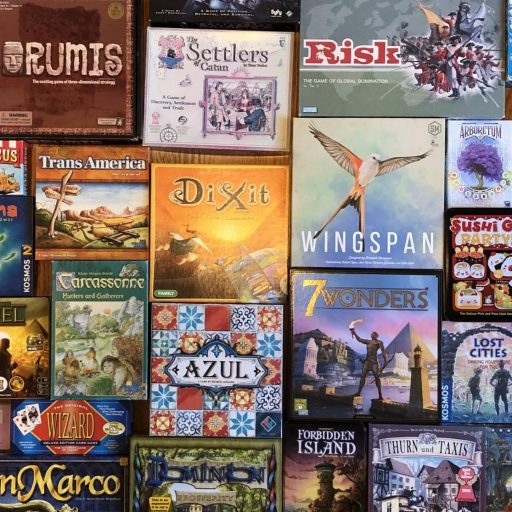For the Love of
Board Games
Board games are awesome – they help us unplug, have fun at home, spend quality time with our partners, roommates, friends and loved ones, relieve stress, exercise our brain cells, get adrenaline going and endorphins flowing.
But how to choose from the hundreds of board games and other tabletop games out there? That’s why I’ve started this site: to share the games we – my hubby, family and friends – like best. I’d call us passionate but not overly geeky board game players. Consequently, most games I recommend here are modern Euro-style, light to medium-weight strategy games that tend to have a nice theme and a good balance between luck and strategy. Games that aren’t too complicated to learn and don’t take all day to play. In other words: Games with just the right mix of fun and challenge, relaxing and engaging!
Have fun reading and, more importantly, playing! And check back often – more game reviews coming soon!
Scroll down and browse games or click and jump directly to recommendations for:
- Jaipur – Fun, quick and colorful little tactical game for two
- Lost Cities – Exciting, quick two player strategy game with simple rules and tough decisions
- 7 Wonders Duel – Engaging, more complex strategy game for two
Games that play well with two or more players
- Azul – Satisfyingly beautiful and tactile, competitive strategy game
- Wingspan – Charming yet competitive, medium-weight strategy game about birds
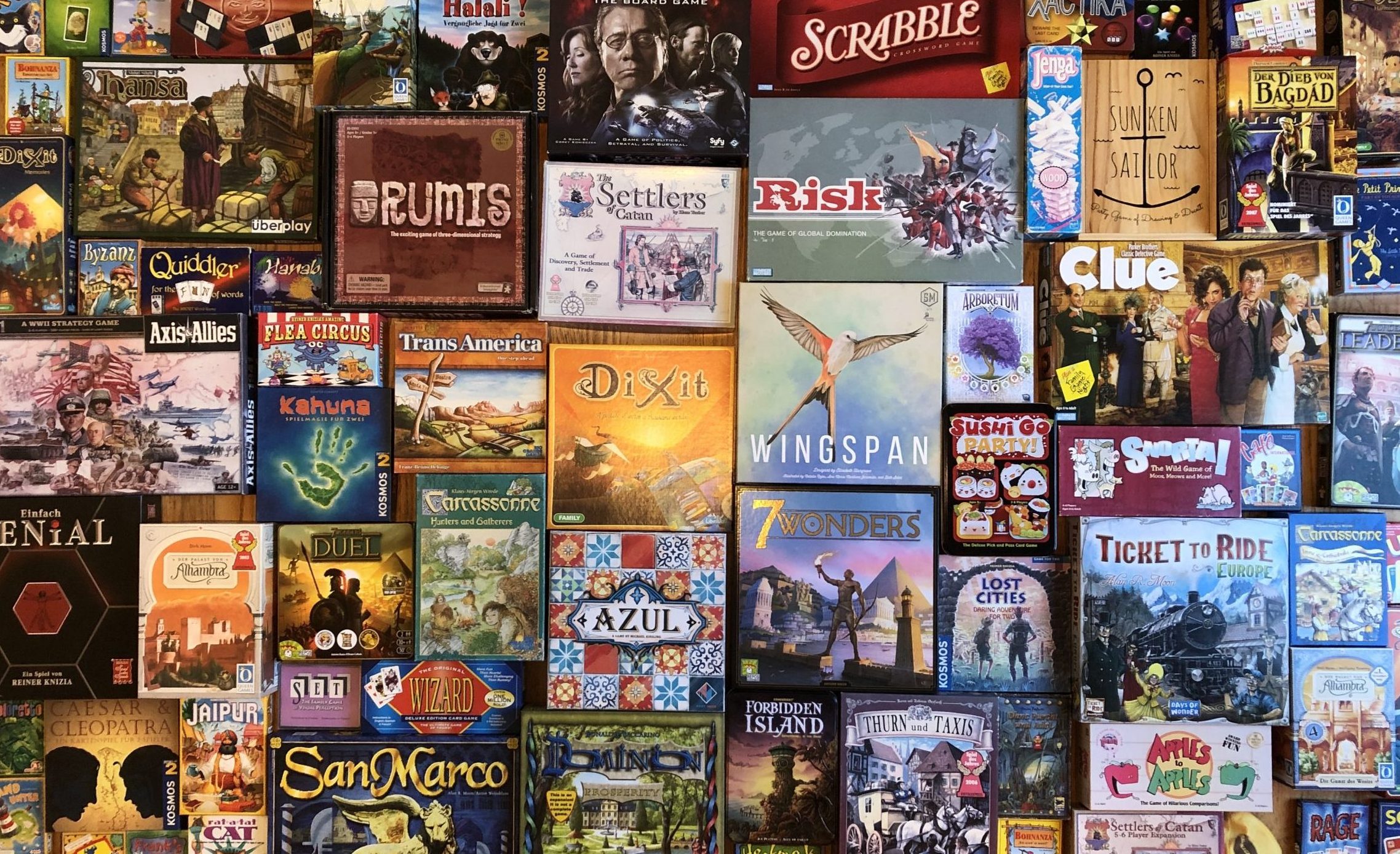
Dedicated Two-Player Games
The following games were designed specifically for two players and are great choices for couples and pairs of players.
JAIPUR
Fun, quick and colorful little tactical game for two
- 2 players, 30 minutes
- Designed by Sebastien Pauchon, published by Space Cowboys/Asmodee
- Won International Gamers Award 2010, category Two Player Strategy Game
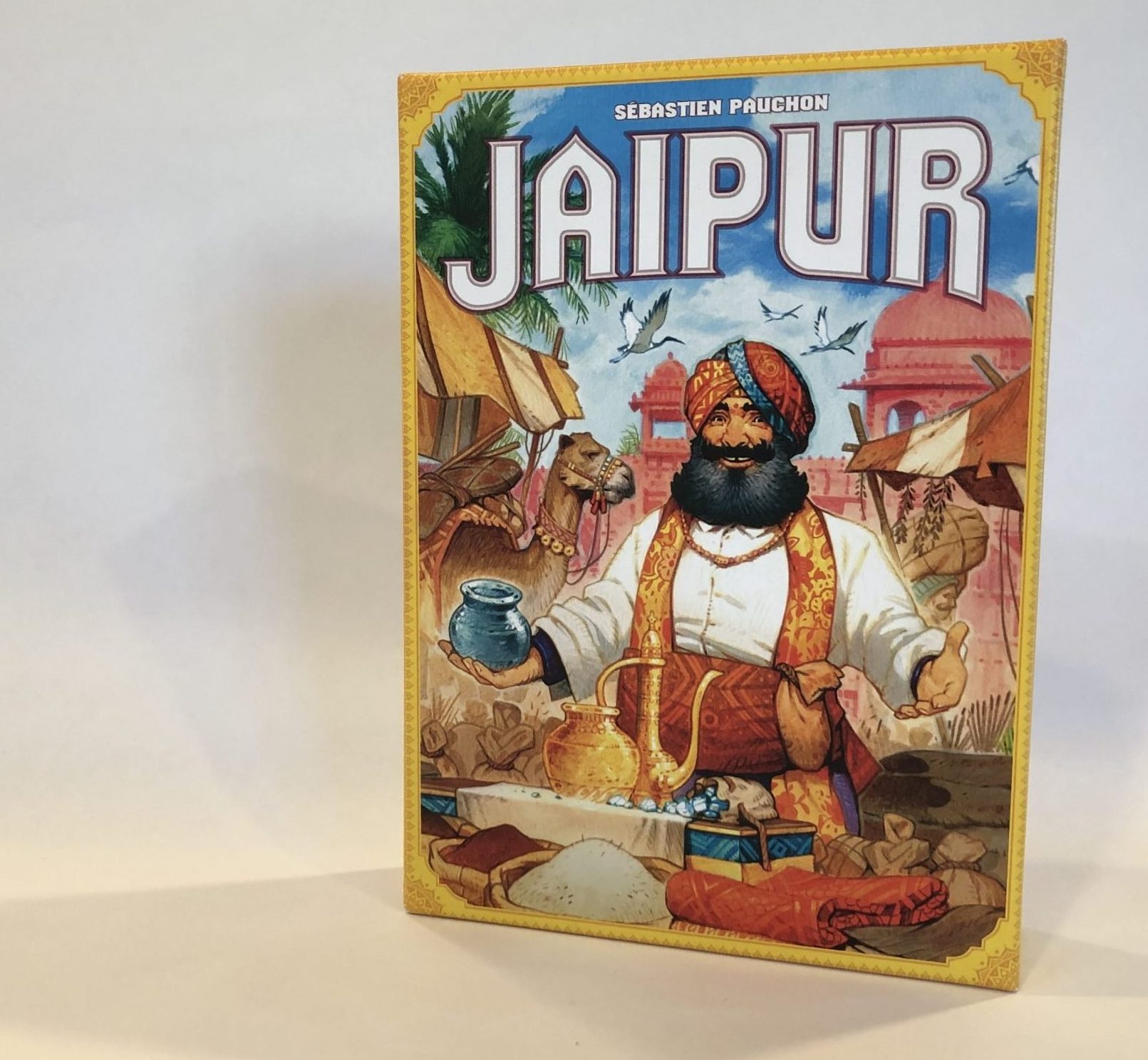
Fast, entertaining and requiring just the right amount of tactical decisions to be interesting and challenging – these are the features that make Jaipur a go-to choice for a little game break or a light after-dinner play session. The exotic trading theme, placing you in a market with cheeky-looking camels and colorful wares like spices, cloth and jewels (as printed on the cards), add that escapist vacation feel we all might be longing for right now.
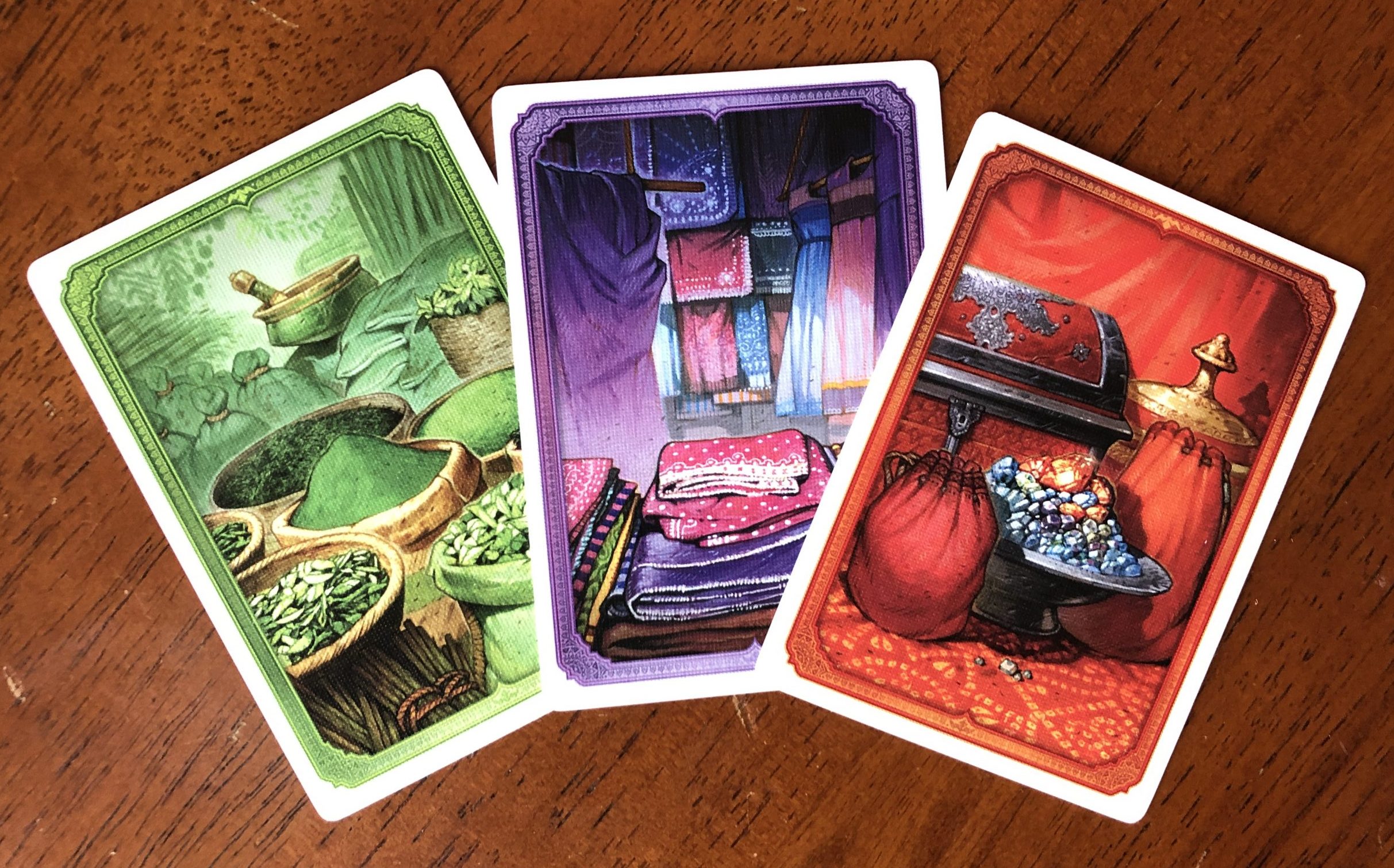
Jaipur life lessons:
- A bit of patience can lead to greater gain
- Don’t be too greedy, or you may end up with nothing!
- Math skills can comes in handy to count your money 😉
Gameplay overview: You aim to make as much money as possible by collecting and then selling market goods at just the right time – collecting three or more will give you bonus points, with more points for more cards sold, while being the first to sell goods of a particular kind will yield the highest price per good (card) sold. This balancing act is at the heart of your decision making.
On your turn, you always take just one action: You either take cards or sell cards. To take more than one of the five cards on the table at any one time, you have to trade the same number of your own goods cards for these cards – which is where the camels come in, since they can be traded in the place of goods that you may want to hold on. A hand limit forces you to prioritize and keeps the cards moving in and out of the marketplace.
A decent amount of luck and randomness – goods and camel cards are drawn from the draw pile to replenish the marketplace, and the amount of bonus points you earn for groups of goods sold varies within a range – keeps the game exciting and from getting overly serious. That said, there are ways to limit your opponent’s good luck by playing the camels wisely…
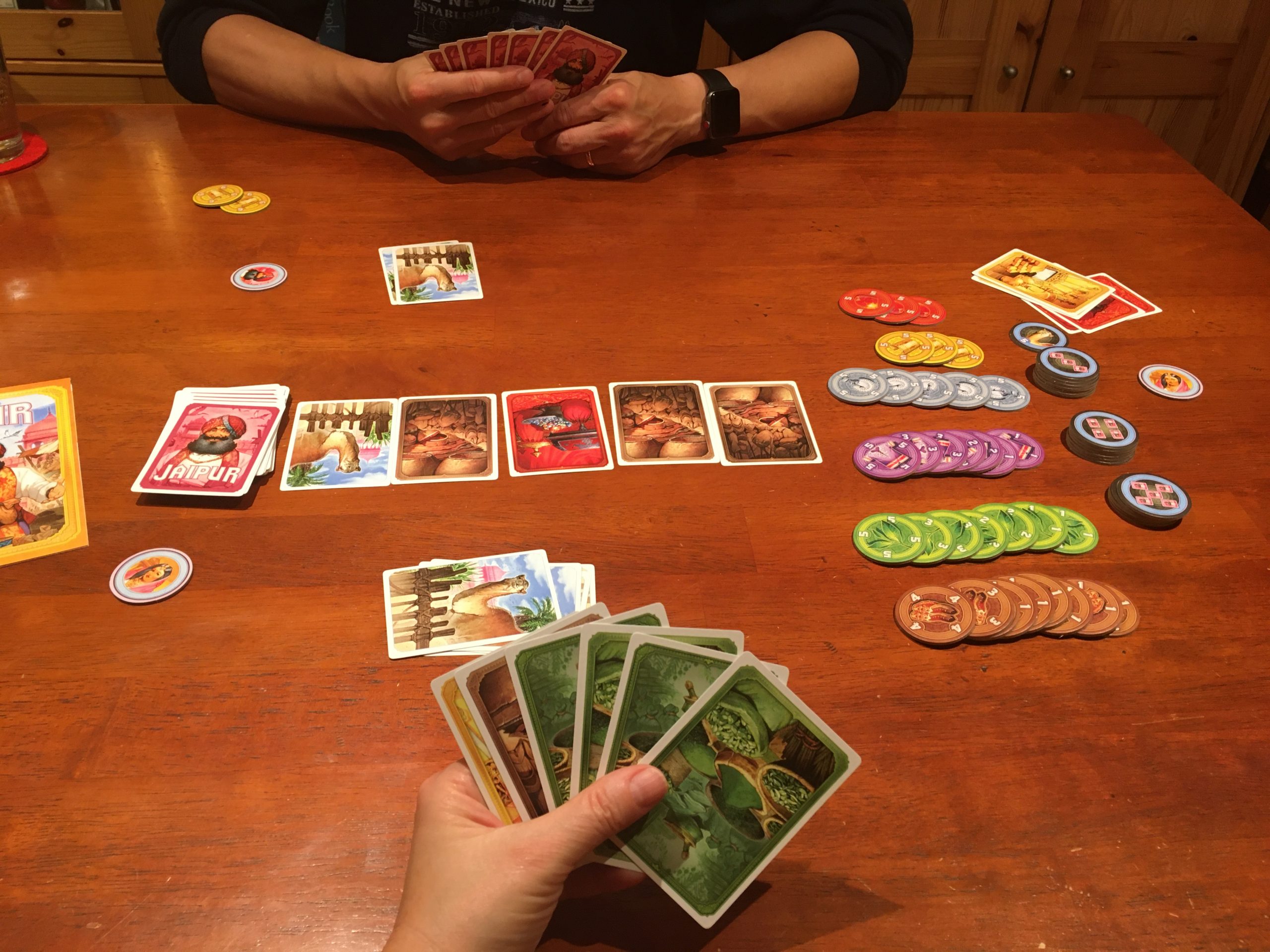
At the end of each round – essentially one game – you add up all the rupees that you have made. Organizing your rupees in stacks of ten each, as suggested, can be a great way for kids to practice some practical math skills. Rupees are represented on sturdy round tokens that you have picked up for each card sold in the market. The winner gets the victory token, and you go on to another game or two, until one player has won twice. Nice touch in the new edition of the game: The victory tokens are two-sided, so you can pick if you want to be the winning Maharaja or the Maharani, the female equivalent.

And that’s pretty much it! But don’t be fooled: The rules may be simple but leave plenty of space for smart tactical gameplay.
What I love about Jaipur:
- Fast moving game
- Near-constant tactical decision making
- Competitive yet not too serious, with just the right amount of luck
- Easy to learn and pick up
- Compact little box
- Attractive, colorful illustrations; sturdy cards and tokens
The not-quite-perfect:
- Makes me feel a bit greedy
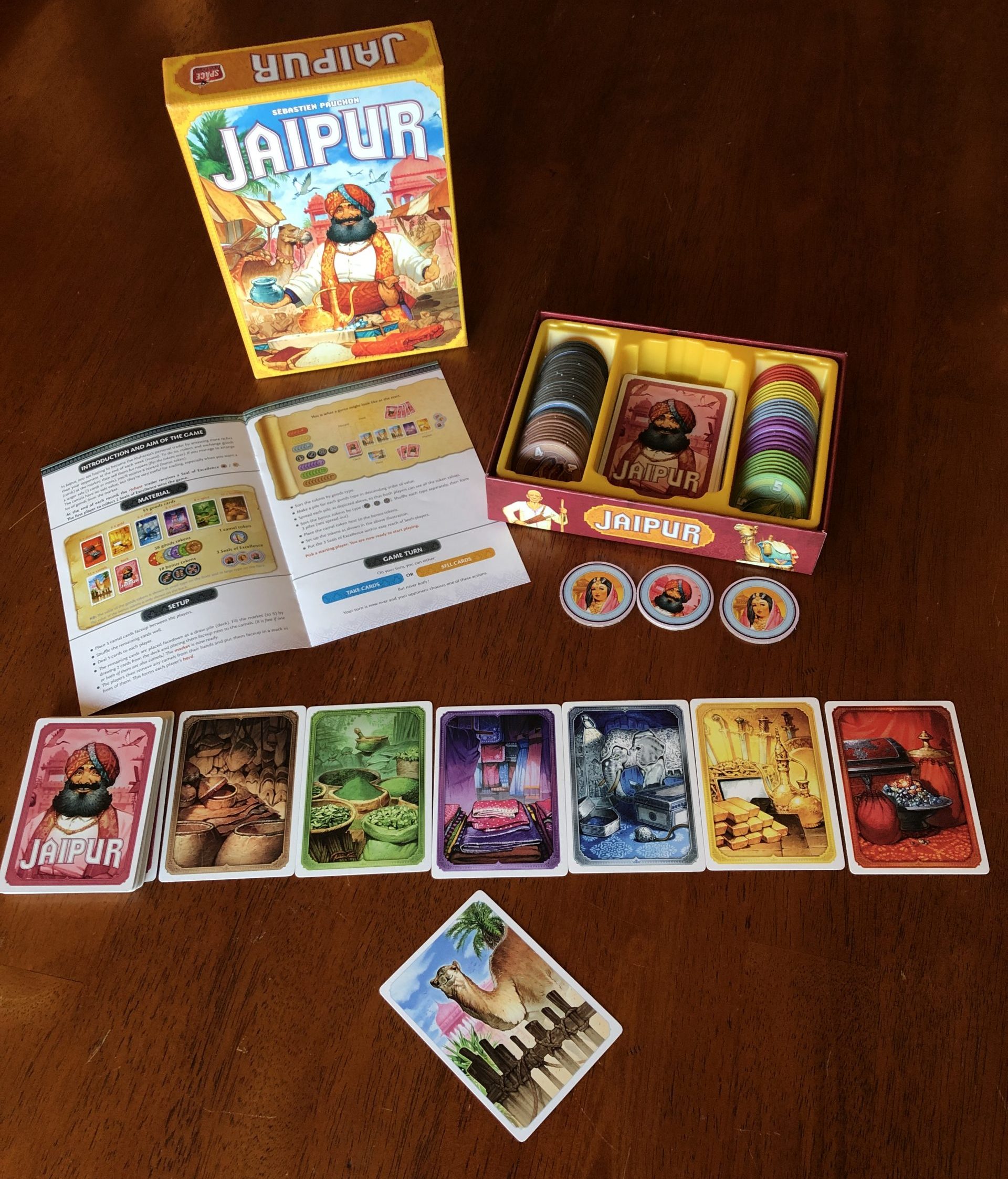
LOST CITIES
The Original Card Game for Two Players
Exciting, quick two player strategy game with simple rules and tough decisions
- 2 players, 15-45 minutes (you choose how many games)
- Designed by Reiner Knizia, published by Kosmos
- Won International Gamers Award 2000
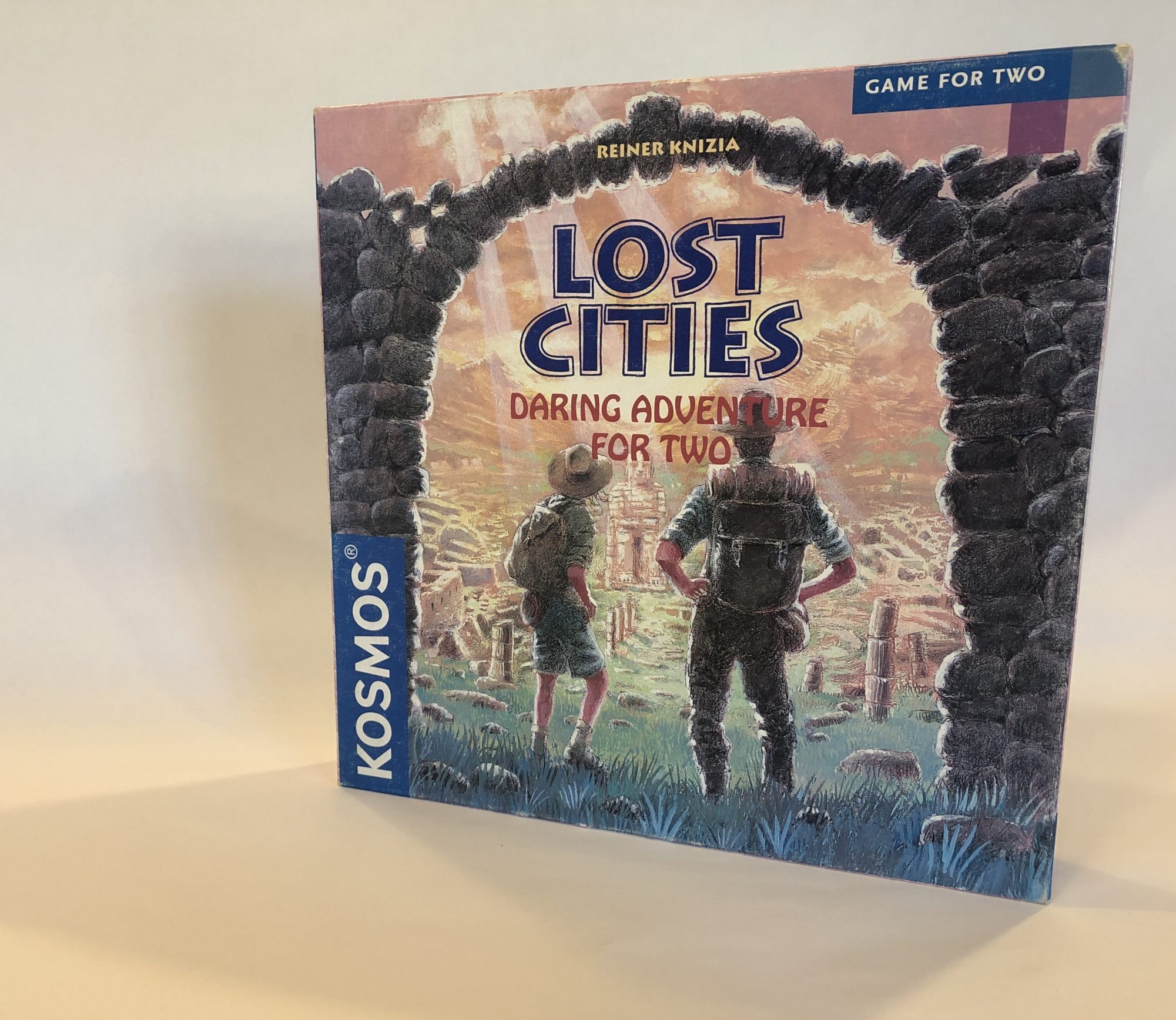
Pleasantly agonizing decisions and adrenalin-inducing tension make for a surprising amount of fun in this deceptively simple card game. Lost Cities strikes a great balance between luck, strategy, and those tough decisions. It’s easy to learn but challenging enough for seasoned gamers. Many couples call this one of their favorite games that both enjoy equally, and it’s been my go-to gift for couples who are interested in playing board games but are not seasoned gamers (yet).
This is not a lean-back kind of game – it’ll keep you on your tippy toes from start to finish. With its intensity, it’s probably a good thing that each game only lasts a pretty quick 15 minutes or so. That way, you can play just one or two games, the recommended three, or even more, if you just cannot stop or want to improve your overall score still.
Lost Cities life lessons:
- Make tough decisions and live with them
- Find a balance between risk and returns
The gameplay mechanics are simple: You always hold 8 cards in your hand (cards come in five colors with values from 2 to 10 or with one, two or three multipliers). On your turn, you first play one card, then take a new one. By putting your cards down in ascending order, you build expeditions, at most one per color. The key is that each expedition needs to break even – any points above a total of 20 per expedition will be positive points, but any numbers you fall short of 20 are negative. Multiplier “investment” cards raise the stakes: Depending on the number of these cards you play, they will double, triple or even quadruple your positive points – or multiply your losses by the same factor.
As soon as you start playing you’ll be faced with challenging decisions: whether to start an expedition; whether to add a card to an expedition, even if that precludes you from adding lower value cards to this expedition later; whether to dare play a multiplier; or if to discard a card and thus make it available to your opponent… Towards the end, it often becomes a race to finish expeditions, since you likely held out as long as possible, hoping for the right cards to still make it into your hand and from there into your expeditions.
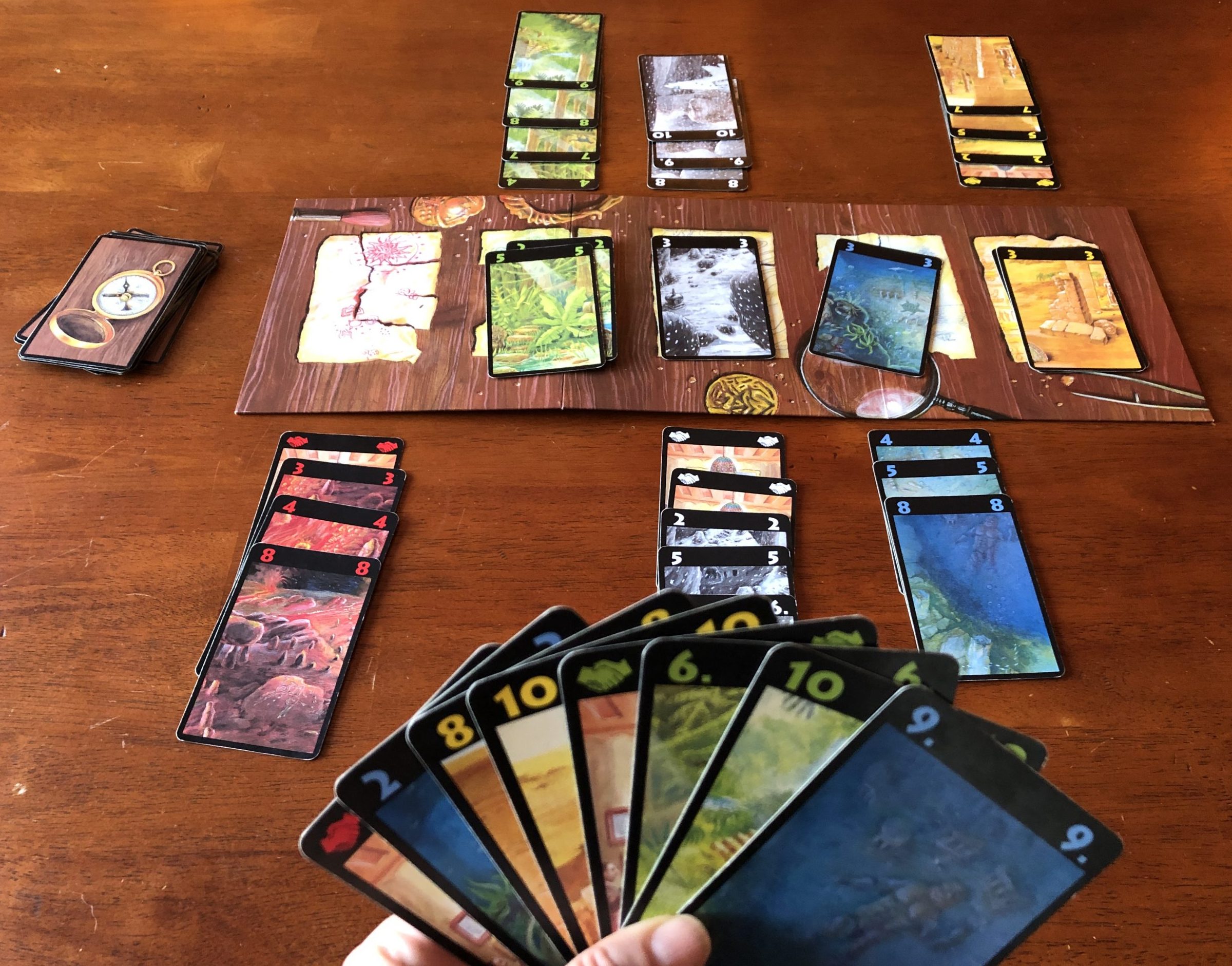
Pictured here is the original edition of Lost Cities, which is visually a bit different from the latest release
The theme – building expeditions to explore ancient ruins in different settings – makes for colorful and interesting playing cards and a cool-looking game board. Beyond that, the theme is not really integrated into the game play and mechanics, nor does it need to be. Simple rules, tough decisions, quick strategizing, an element of luck and a good dose of tension and competition combine to a thrilling and fun game for two.
Scoring requires a bit of arithmetic, and ideally pen and paper for each player.
A note about playing with kids: The box of the original release says 13 years and up, and while the new version has dialed this down to 10 and up, some kids may well be ready even before then, especially – but not necessarily – if they like math and numbers. To make it easier for young or new players, you can start playing without the multiplier cards and add those later, to add stakes and complexity once all players have the concept and mechanics down. The arithmetic required for scoring might be a fun way to apply new math skills for elementary school-aged kids.
Pictured in this review is the original version. A new version of Lost Cities – The Card Game includes the original game (with new, bolder graphics) and also a sixth expedition/color and a two-sided game board to play a variant with the sixth expedition.
What I love about Lost Cities:
- Clean rules that are quick to learn
- Simple game mechanics
- Nice tension, agonizing (in a good way) decisions
- Requires some strategy
- Just the right amount of luck to keep things exciting and make every game different
- High replay value
- Quick to play, so you can always squeeze in a quick game or two or make it a longer session
- Relatively small box
- Very affordable
- Lots of fun!
The not-quite-perfect:
- Cards are very large and therefore a bit hard to mix for small hands
- In the original edition, it can be hard to distinguish the colors of the expeditions on the game board, but the new edition is a lot clearer on that.
Note that the game reviewed here is the original Lost Cities card game for two players. Reiner Knizia later also designed “Lost Cities – The Board Game,” which can accommodate two to four players. The board game has a similar theme and cover but quite different game play. Make sure you pick the right game when shopping!
7 WONDERS DUEL
An engaging, multi-dimensional strategy game for two
-
30 minutes, 2 players
-
Designed by Antoine Bauza and Bruno Cathala, published by Repos Production/Asmodee
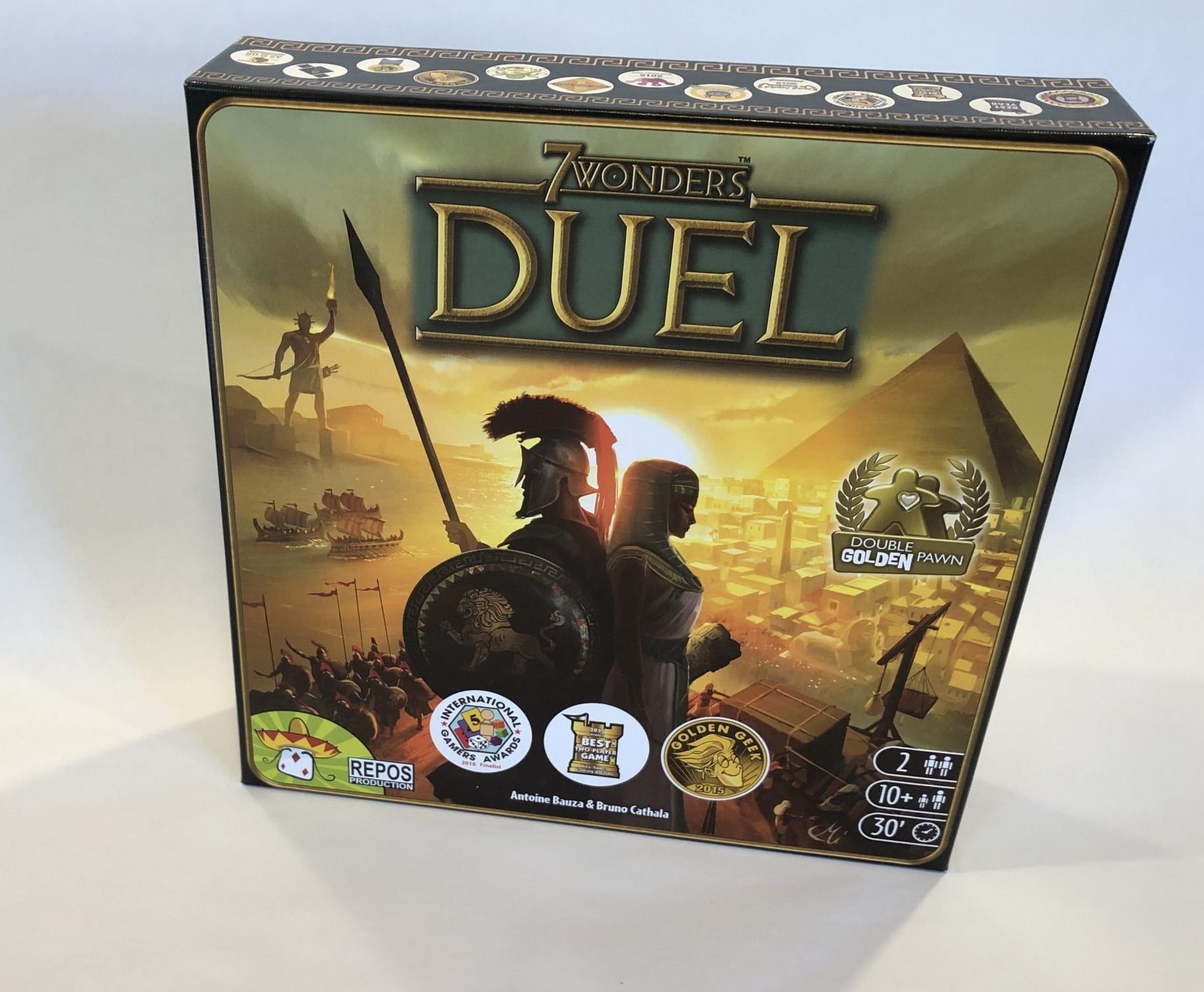
Note: This is a review of the stand-alone two player game. For a comparison with the original 7 Wonders game for 3-7 players, see below. For a full review of the original 7 Wonders multiplayer game, go here.
If you’re short on time but want an interesting, somewhat more complex two-player strategy game, 7 Wonders Duel is a great choice: It packs a lot into a game lasting about a half hour, from an interesting card drawing system to an engine building mechanism that will allow you to build more and more of your ancient civilization. While there are many ways to collect victory points within your own civilization, you are also forced into military battle with your opponent. Being a pacifist is not a choice here, since it will cost you the game – it truly is a duel!
The many different facets of the game, the strategy and tactical decisions it requires, and enough luck and randomness to keep things exciting and different each time combine into a competitive game that should be interesting for two more seasoned players but not too heavy for relative beginners.
7 Wonders Duel life lessons:
- When things seem complex, just tackle them, and before you know it, they’ll seem simple!
- Don’t be too focused on any one thing, or else you may miss opportunities and your competitor might beat you before you know it
- Sure, there is some luck, but focus on what you can control!
Gameplay overview: Set in an ancient world, each player builds their own civilization or city. They take turns choosing one card at a time, which they use immediately to build different structures (including those that produce resources) or one of their four ancient wonders, paying the price indicated on the structure or wonder card. Alternatively, they can discard the card for money, which is used to acquire resources to build structures and wonders. Some structure cards carry victory points or provide resources or other benefits on their own, while others become more valuable in combination with other cards.
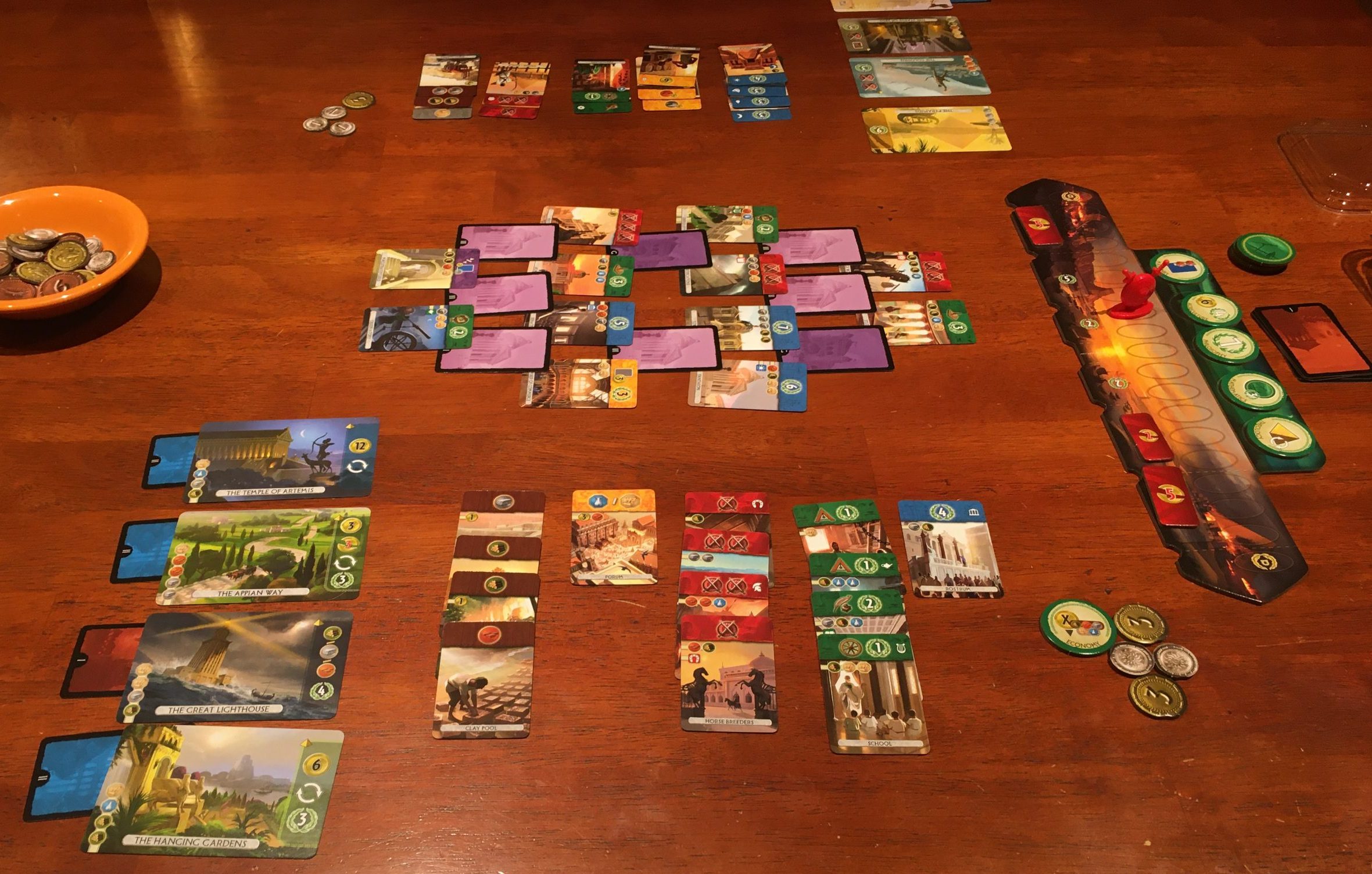
The game plays over three phases or “ages.” Each age offers a different set of cards, becoming both more expensive and more valuable with each age. As you draw face-up cards from intricate patterns, you reveal and make available more and more cards. This nifty drafting mechanism introduces more excitement and allows for more tactical decisions, since you can try to get to a certain card first, or you may try to prevent your opponent from getting to a specific card on their turn. This is also where the extra turn power from some wonder cards can become very valuable and make for interesting game plays and surprises.
You win in one of three ways: You claim sudden victory if you either have a certain number of scientific structures or reached your military goal. If that does not happen, you play to the end of the third age and then tally points in eight categories in the provided score pad. These multiple paths to victory keep the game close and tense throughout, since you cannot afford to disregard any of them.
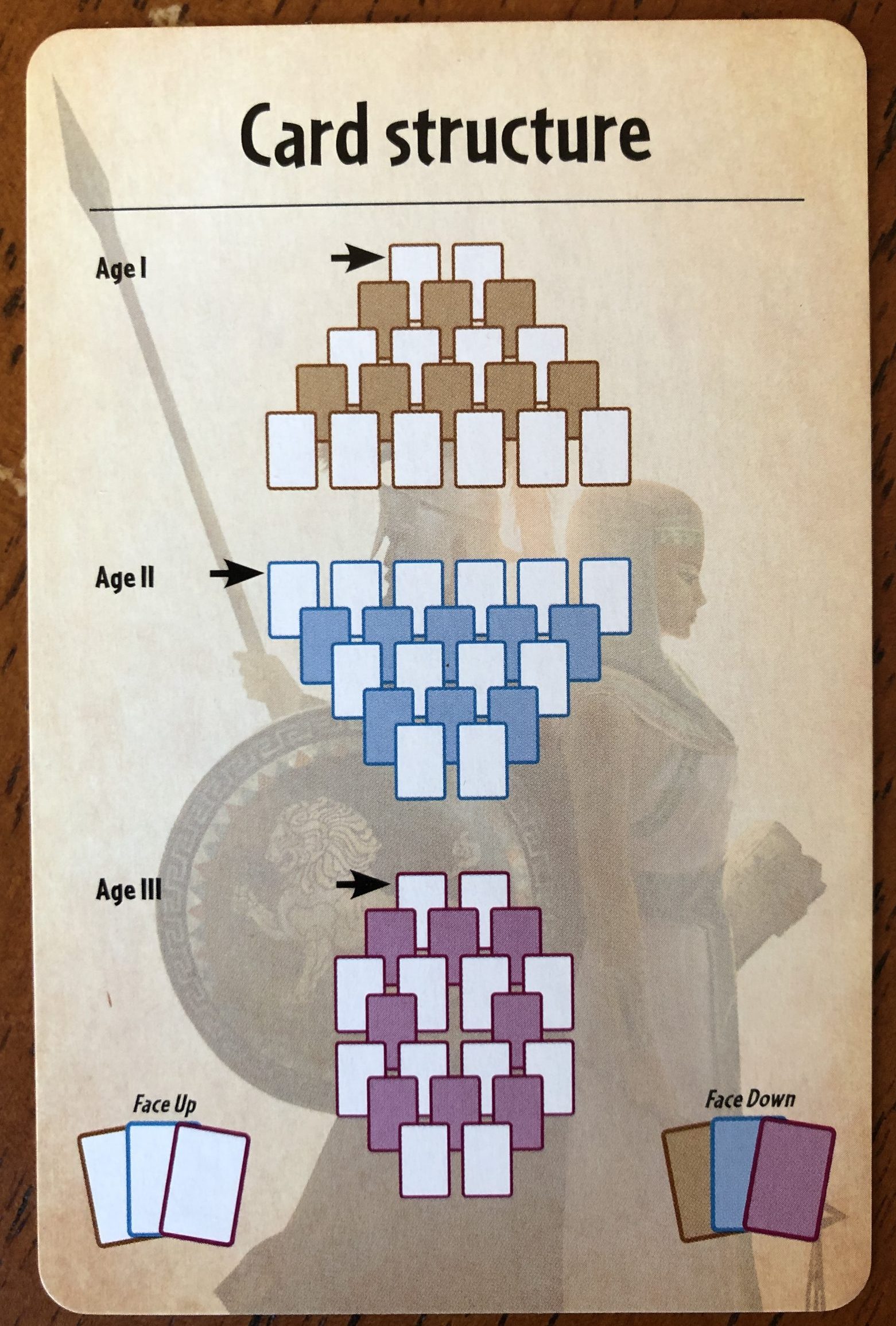
Luck and variability come into play in several ways: In addition to the structure cards being laid out randomly, half of them face down to be turned up and unveiled as the rounds progress, there are always some cards per age taken out at random, so you don’t know for certain what structure cards will be available in a game. Also, players take turns choosing their four of eight randomly chosen wonder cards, changing it up that way as well. Interestingly, while cards come up at random, players usually still have a degree of control over which ones they will choose.
Interaction is mostly comprised in competition: While you build your individual cities, you go head to head with your opponent on military, trying to march towards your opponent’s capital on a dedicated small score board, likely pushing each other back and forth. You also compete over the cards and over building your very valuable but expensive wonders at just the right time – wait too long and you may not be able to, since only 7 of a total of 8 wonders may be built in a game; build them early and you may not make best use of their special powers. You definitely need to keep an eye on your opponent’s moves, to avoid defeat by sudden victory.
The theme of ancient wonders and civilizations feels very present in the nicely illustrated wonder and structure cards. Structure cards are tiny, helping to keep the required tabletop space down, but all the important symbols are big enough to easily recognize in your opponent’s layout across the table.
Ease of learning: The gameplay contains a lot of intricacies and details you need to pay attention to. This makes it interesting and engaging but may feel a bit overwhelming to new players. The rulebook does a great job explaining and illustrating the objectives, game play, different cards and components as well as the set-up. The mere fact that it is 20 (smallish) pages long tells you that there is quite a bit to learn, though you’ll get the hang of it fast as you get playing. The rules are actually quite simple and the cards self-explanatory, once you’ve learnt the basic symbols, so you won’t have to refer to the booklet much going forward. Should you be familiar with the original 7 Wonders multiplayer game already, you will only need to learn the rules and mechanics that are different.
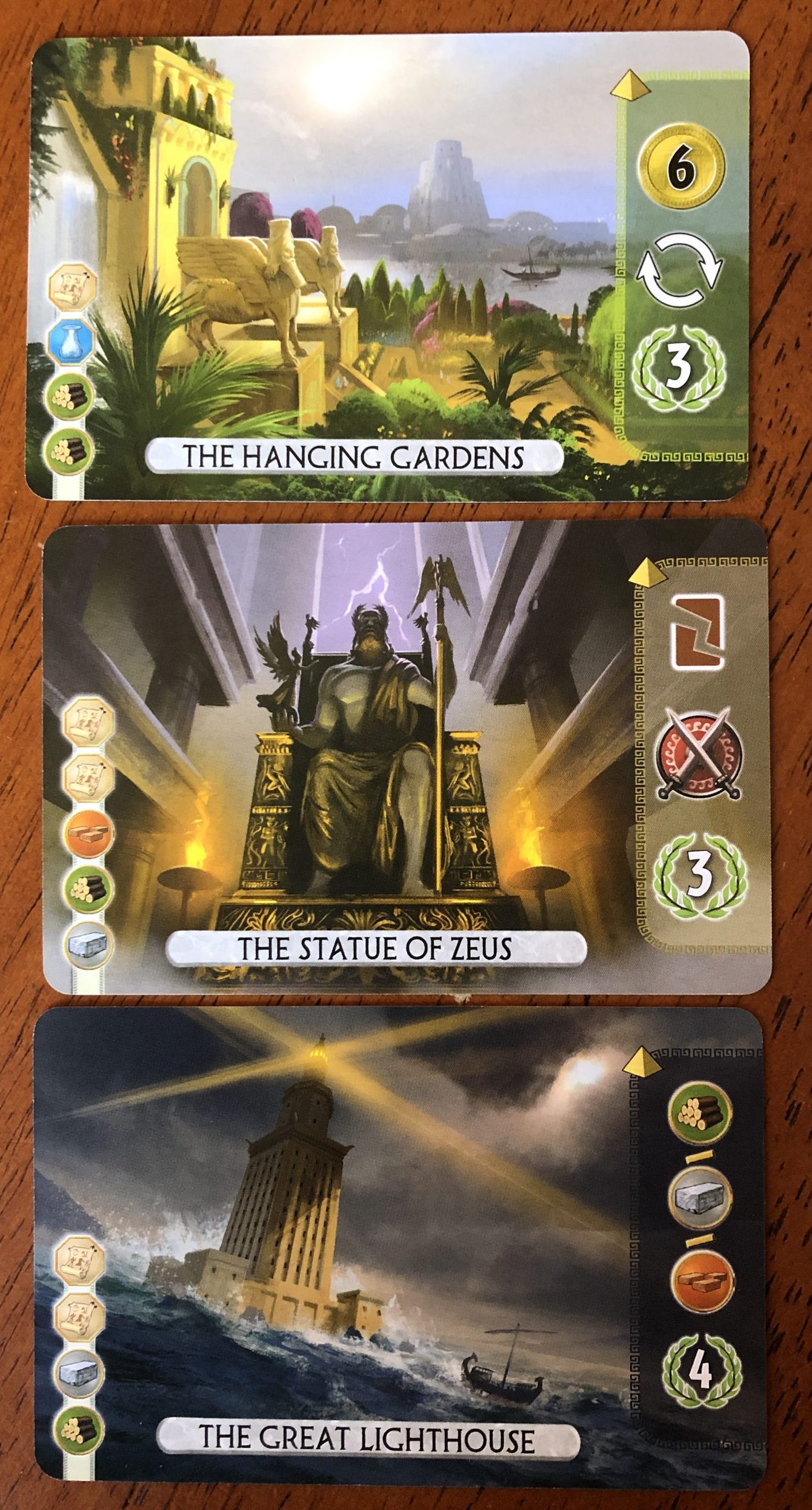
Overall, I would recommend this game especially to couples and other players who have some experience playing strategy games already and are not intimidated by learning a more complex new game.
What I love about 7 Wonders Duel:
- Cool card drafting mechanism that mixes luck and tactics
- Many layers, dimensions and ways to win
- Good tension and interesting decisions
- Might seem complex but is actually straight forward and logical, not the “I need to read up on what this card means again” kind of complexity
- Good replay value, aided by a variety of wonder cards and the random distribution of structure cards
- Challenging but not too demanding
- Fast game, may allow you to play a rematch
- Very nice graphics, design and components
- Compact box with well designed compartments to store the different components
- Lots of complexity in an affordable package
- Great redesign of the popular multiplayer game 7 Wonders to feel familiar yet fresh, different and decidedly like a solid two player game
Good to know:
- Requires a decent amount of tabletop space for a two-player game
- No reading or language required once you’ve learnt the rules
The not-quite-perfect:
- Might seem complex to beginners and new players at first
- A few minutes of set-up required for each game and round
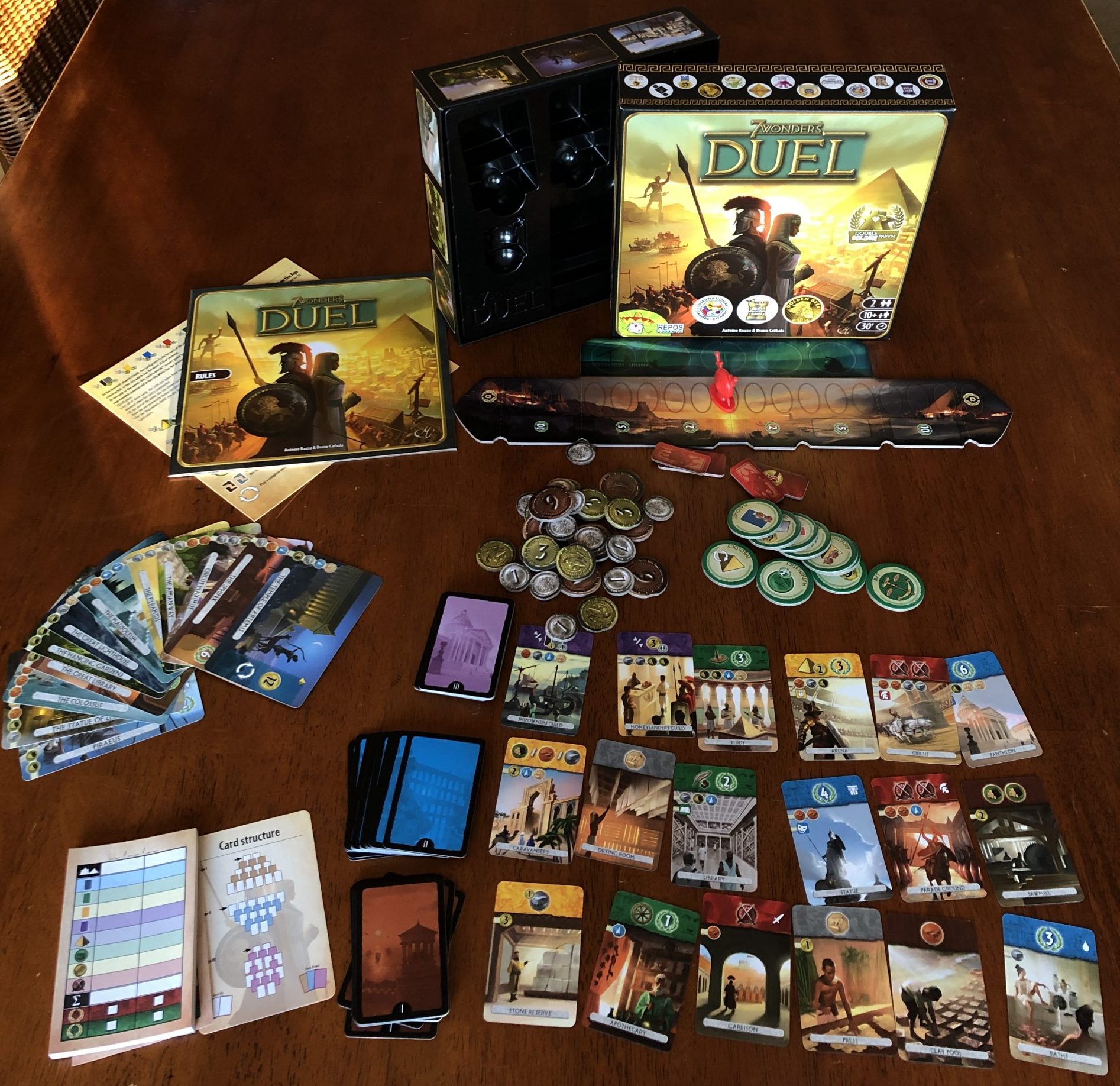
Comparison with the original 7 Wonders:
If you like the original 7 Wonders for multiple players, you should find 7 Wonders Duel to be a challenging, satisfying two player game that feels familiar yet refreshingly different. In fact, you might like it even more, since – as the name “duel” promises – there is more direct competition with your opponent, resulting in more tension and additional strategy and tactical decision-making. Duel is not some cobbled together variant of the original game but a solid game for two. It has been thoroughly re-designed without compromise, keeping the theme and many of the mechanisms intact while introducing new, interesting features that make up for loosing one of the best features of the multiplayer game, the simultaneous game play.
Here are some of the main differences between 7 Wonders Duel and the original multiplayer 7 Wonders:
- Definitely a duel, with more head-on, direct competition
- Players take turns, rather than choosing cards and then building at the same time
- More ways to win: In Duel, you may also tally the winner by scoring and adding points from different categories like in the original – but only if no one has not yet claimed sudden victory through military or sciences before the end of Age III. So neither player can afford to completely disregard these two categories (nor rely on them, either), and you’ll have to adjust your strategy accordingly.
- Different mechanism for choosing cards: In Duel, cards are laid out in an intricate pattern, some face up and others face down, which will be revealed successively as other cards are taken. It’s quite genius, actually – it keeps things exciting and also allows for additional strategy (how can you play to get a particular card you want or prevent your opponent from getting a card that might hand them the win?)
- Overall feels more challenging with more room for tactics and strategy
- Instead of one Wonder board, you receive four Wonder cards. Some of these contain a “take another turn” power, which you can cleverly use to gain and build a choice second card (see above).
- Resource prices go up with the number of resources your opponent holds. Also, you pay the bank and not your opponent. Money overall feels more important in Duel.
- Duel looks and feels a bit different, too, with more and different components, smaller cards, no individual wonder boards but a joint military score board.
Games for two and more players
What if you could play the same great game with two players and with more people on social occasions as well? Or, put differently, if you and your partner, room mate or best friend could enjoy a multiplayer game that feels just like a great two-player-game?
Luckily, thanks to brilliant design, a few games do just that: play really well with two player but also with groups of people – and some can even be great fun for solo players as well.
My favorite games in this category include (more on each below):
- Azul (2-4 players)
- Wingspan (1-5 players)
AZUL
Satisfyingly beautiful and competitive strategy game that works equally well for two, three or four players
- 2-4 players, 30-45 minutes
- Designed by Michael Kiesling, published by Next Move/Plan B Games
- Multiple awards, including “Spiel des Jahres 2018” (game of the year 2018), one of the highest honors in the board game world.
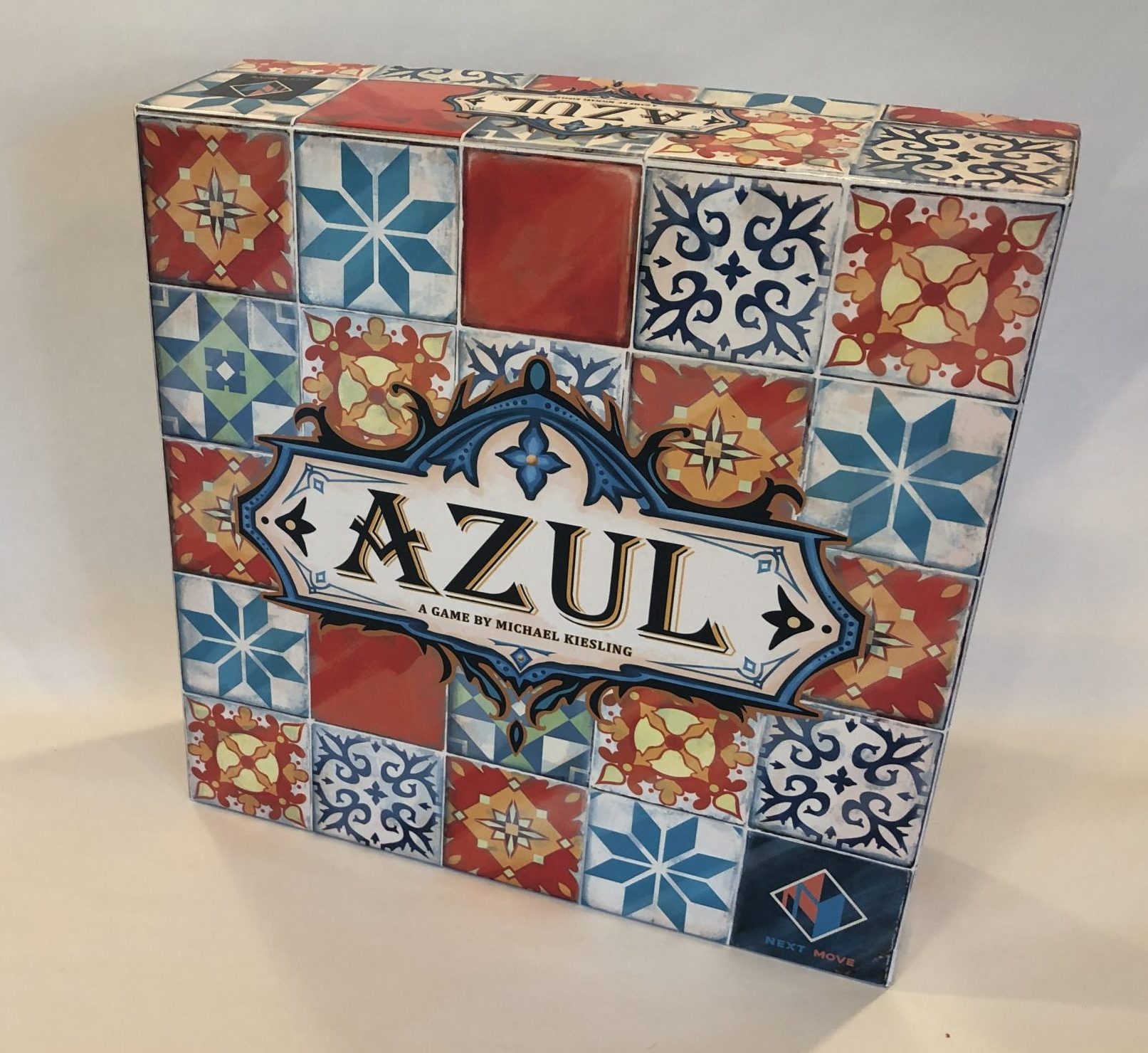
The fun begins when you hold the beautiful box, and it continues as you unpack: The four game boards are sturdy and richly illustrated, as are the nine round “factory displays” that hold the tiles. The 100 tiles themselves – 20 in each color – are pretty and chunky. Tiles are stored in and drawn from a cute cloth bag that is decorated with more of the Portuguese tile work that forms the thematic backdrop to this game.
Fortunately, the gameplay is equally attractive: Azul plays refreshingly differently from any other game I know. The rules are simple and straightforward, but the game requires smart strategizing and lots of tactical decision-making. The random distribution of tiles and the actions of your opponent(s) keep things exciting and a bit tense. Add to that that the game plays fantastically well with either two, three or four players, and you have a game with high replay value that will last you well beyond the pandemic.
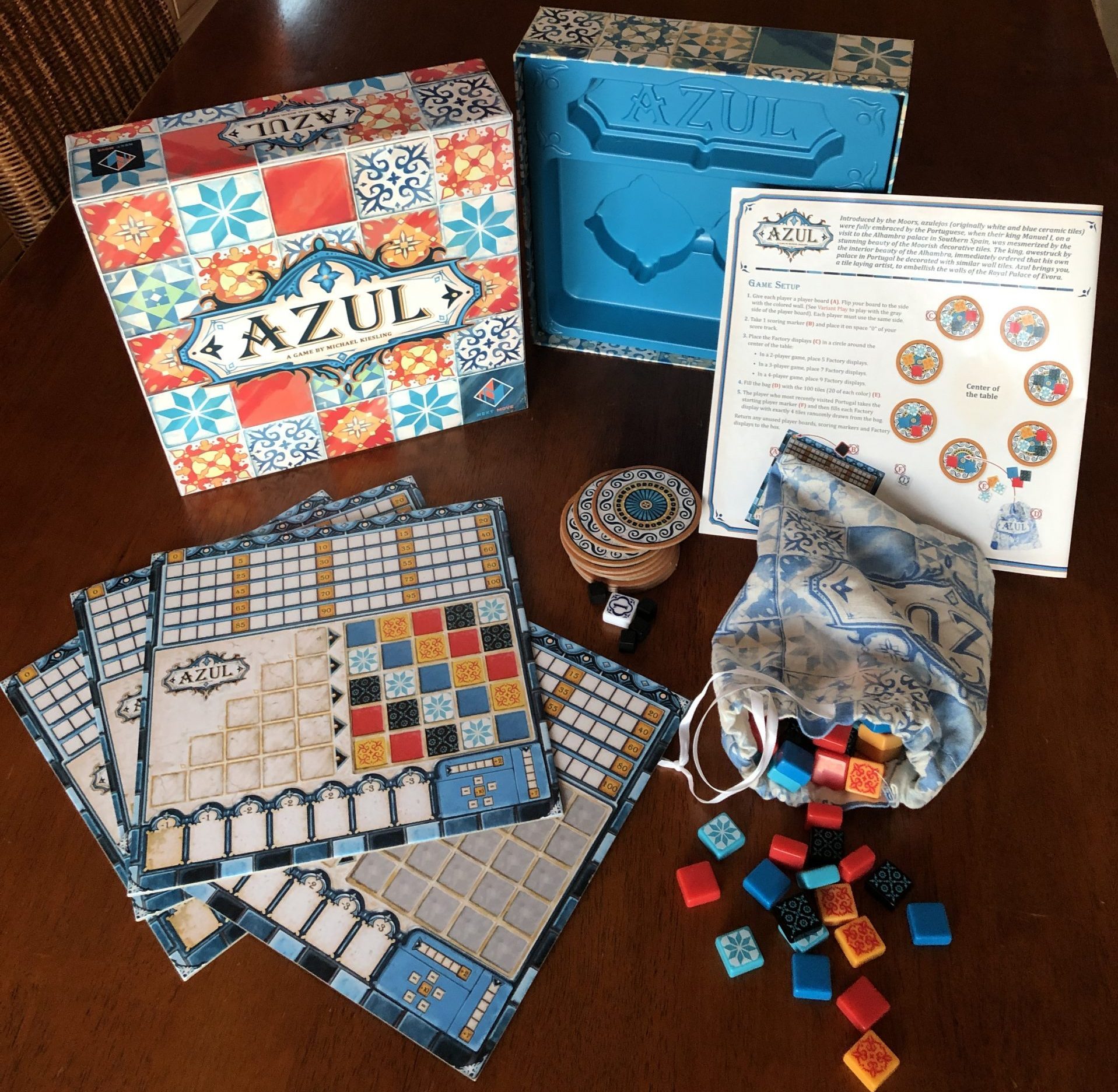
Azul Life Lessons:
- Have a plan but remain flexible and open to new opportunities that present themselves
- There are multiple ways to get to the win
- Sometimes, it’s worth paying a higher cost upfront for greater reward later
- Pretty doesn’t always win
- Being first is not necessarily best
Gameplay overview: In short, players draw tiles and place them to score points. Each game plays over several rounds with two phases each: Players first take turns drawing tiles and placing them in the slots on the left side of their boards. This can be trickier than it sounds: You always have to take all tiles of one color from either one of the round “factory displays” or the middle of the table, and you can only place them in one row, and only if there are no other color tiles in that row and if you have not already placed that color tile in its corresponding spot on the right. When all tiles in a round are taken, players move their tiles into the respective row and spot of the five by five tile laying square on the right side of their boards. Every type of tile can only appear once in each row or column. Players score their own points on their individual game boards as they place the tiles. There are ways to maximize points as you lay down tiles by placing them adjacent to others and extra points to score at the end of the game, for completed rows and columns as well as having placed all tiles of one color.
The rules and mechanisms make for interesting decisions. Do you try to score as many points as possible by laying your tiles in tight clusters as you go along, or do you aim for juicy bonus points at the end that may require you to spread out your tiles? Is it worth taking on a penalty of negative points by taking more tiles than you can fit on your board? Do you draw the tiles you need even if that results in offering the next player exactly what they are hoping for? It’s amazing how much thought and strategy can go just into drawing tiles!
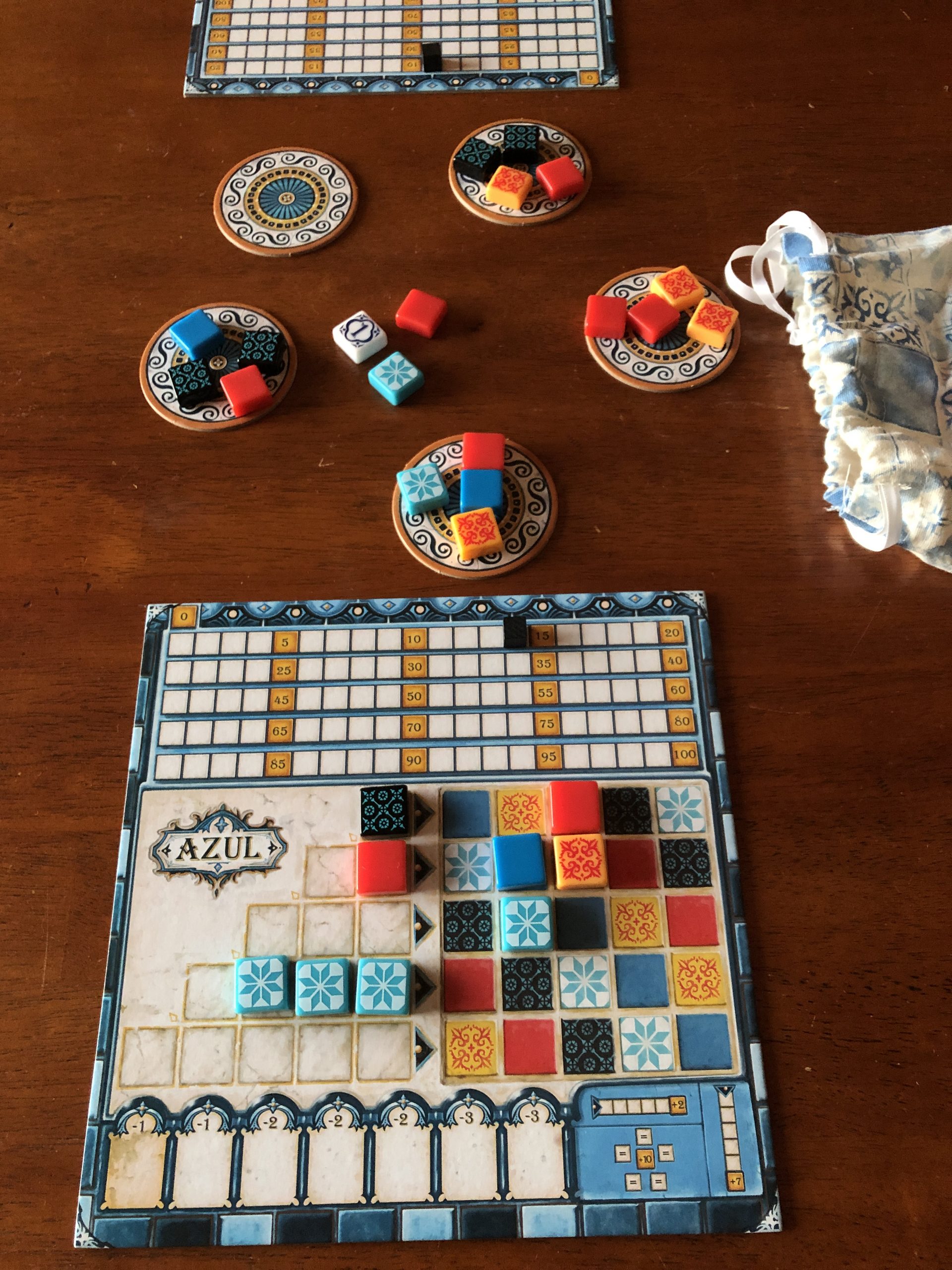
The game ends when the first player has completed a horizontal row. However, finishing first does not guarantee a win and is not necessarily desirable. Therefore, games often keep going for several rounds past the first time a player has had the option of finishing a row and, with it, the game. This results in more tension, excitement and decisions, since you don’t know how many more rounds you have to lay tiles and score points.
The game scales well to different numbers of players by setting up with varying numbers of “factory displays” and therefore tiles per round.
A warning, of sorts: With the pretty colors and designs, some players might be tempted to draw and play their favorite tiles, even if that is not the smartest move for scoring points. This could especially be an issue for kids – but then again, they may be happy even if they lost because they made a pretty pattern 🙂
Variant: The backside of the game boards contains a variant to Azul for advanced players. Here, you can lay your tiles in any place in the corresponding row at right, creating your own pattern. However, there can still only be one of each tile type in each row and column. This variation is quite challenging and it’s easy to make a mistake – i.e., placing two of the same tiles in a row or column. If you don’t discover the mistake right away (trust me, it’s easier to miss than you may think!), it basically blows up that game, which can be very frustrating. But if all players pay close attention to everyone’s board, this can be a great way to take Azul to the next level.
Interaction and engagement: While each player focuses on placing tiles on their own board, your game play is intimately involved with that of your opponent(s), and there is plenty of indirect interaction. Since all players take turns drawing from the same supply of tiles, you’ll hold your breath for the tiles you want and may have to quickly adjust to what’s actually available on your turn. Sometimes, the availability of tiles changes in your favor, so it’s important to remain flexible and take advantage of new opportunities. Also, while you will mostly play to increase your own chances of winning, you can also be mean and sabotage your opponents’ plans by drawing certain tiles that you know would be perfect for them, or by forcing them to take on negative points. These dynamics can make the game quite competitive and even cut-throat, especially in a two player game where your actions directly impact each other.
Ease of learning: Even though this will be a different type of game for most, the rulebook does a decent job explaining the mechanics and gives many illustrated examples (plus, there are always “how to play” videos to watch). Players should get the hang of it within a round or two – though learning all the tactical nuances and honing your strategy will take quite a bit longer.
What I love about Azul:
- Very versatile – plays well as a two-player game or with small groups
- Interesting game play with plenty of room for strategy and tactical decisions
- Beautiful and high quality game components and box
- Multiple ways to score points
- Good balance of strategy, tactics and luck
- Can get quite competitive and tense
- High replay value plus a variant for advanced players
- Not too hard for beginners but also interesting for more seasoned gamers
- Scoring mechanism is integrated into each individual game board
- Relatively quick game play – satisfying enough to play just one game, but short enough in case you have to play a rematch
The not-quite-perfect:
- It’s easy to accidentally move the little scoring marker, creating confusion about a player’s score
- Could be even prettier if all five tile types had designs on them – two are just plain red and blue
For even more fun: Azul is great out of the box. But if you’re a fan already, or know others who are, you can find fantastic aftermarket pieces on Etsy that promise to enhance the joy of playing Azul even further. My favorites: Gorgeous wooden factory display tile holders and game board overlays in blue and brown that aren’t just pretty but also keep the tiles and the pesky little score markers in place, and more affordable acrylic board overlays that also keep tiles and markers from sliding around.
WINGSPAN
Charming yet competitive, medium-weight strategy game about birds. Plays well with couples, groups and solo players.
- 1-5 players, 40-70 minutes
- Designed by Elizabeth Hargrave, published by Stonemaier Games
- Prizes and accolades: Many, including “Deutscher Spielepreis 2019” (German Board Game Prize), “Kennerspiel des Jahres 2019” (best game of the year for more advanced players), “America Tabletop Awards: Best Strategy Game,” seven categories of the “Golden Geek Awards,” and many more.
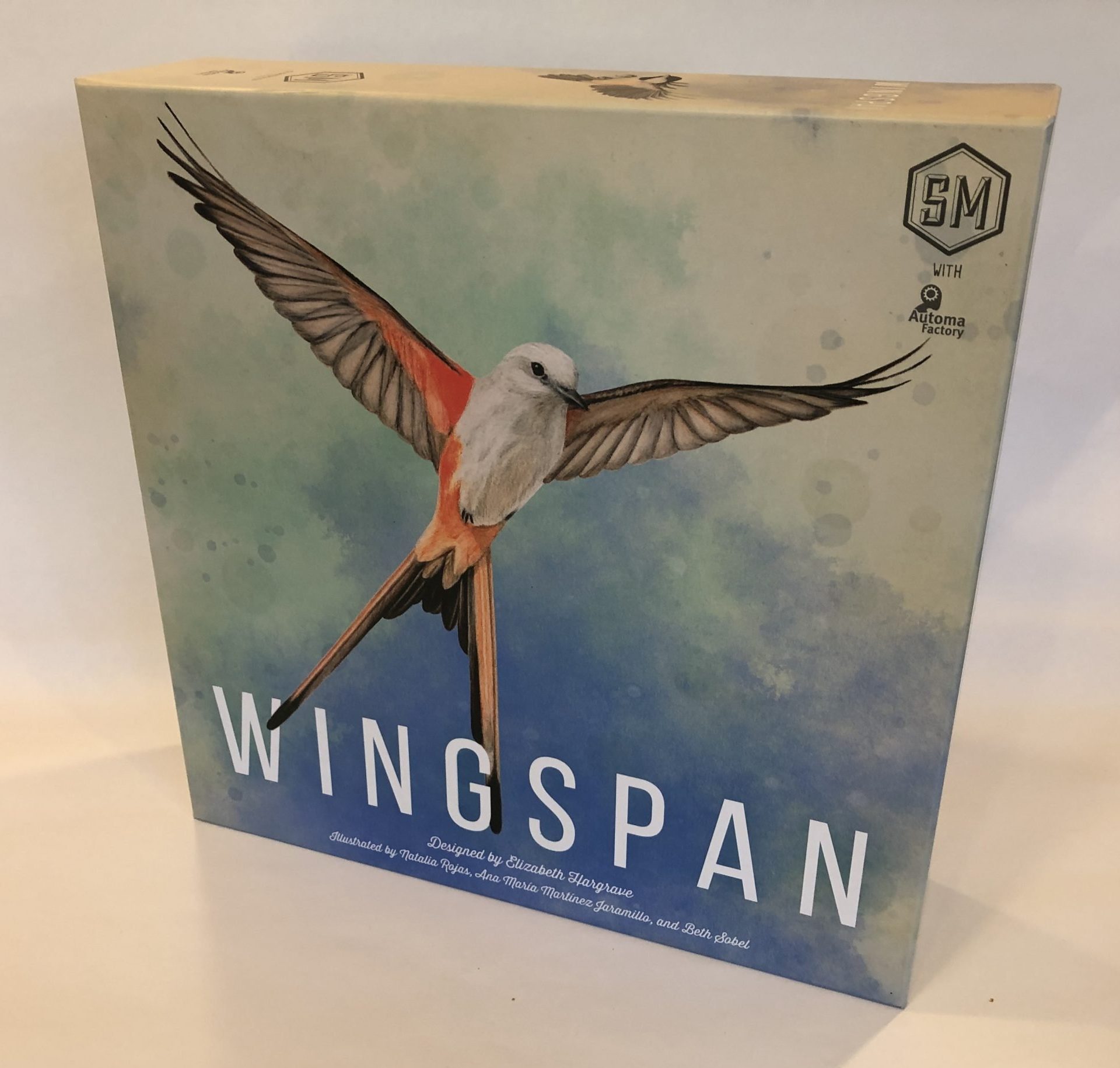
A word of caution: Once you start playing Wingspan, you may never look at birds the same way again. And the sight of a Red-tailed Hawk circling overhead, a Blue Jay landing on the fence or a little House Sparrow scurrying about may trigger the urge to play Wingspan – yet again!
Wingspan is an all around excellent game, but two features really make it stand out: (1) birds are not just a cute backdrop theme but the heart and soul of this game, with their features fully integrated into the gameplay, and (2) this is a rare popular game designed by a woman, Elizabeth Hargrave. She loves nature and board games and combines the two expertly. The beautiful bird cards are also illustrated by three women, for a total of four names of females on the box, in case you – or your children! – are keeping track.
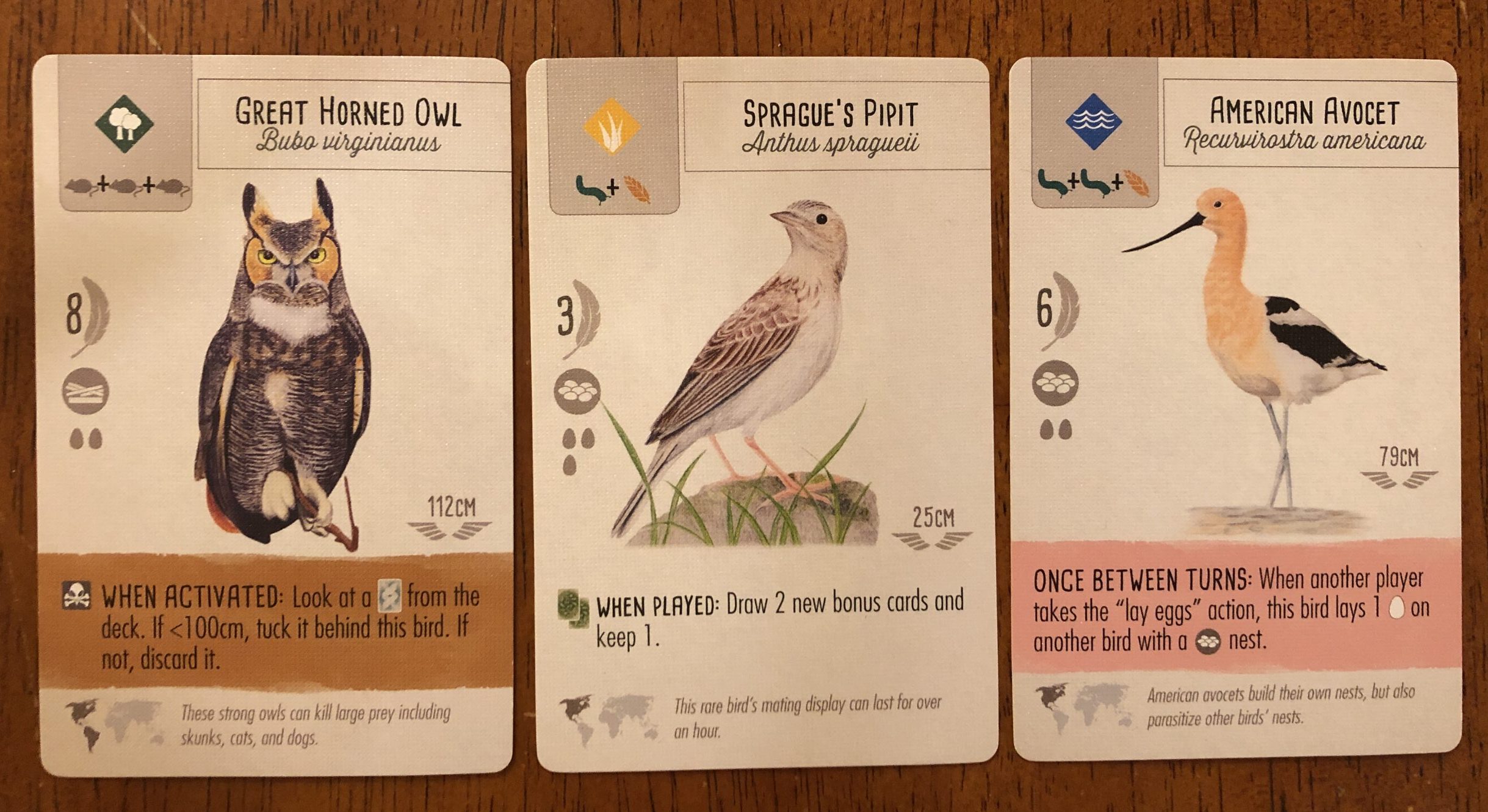
But those are far from the only reasons to love this game, which is great for any number from one to five players. Elizabeth Hargrave describes her game as “a competitive, medium-weight, card-driven, engine-building board game” – we’ll see how this plays out in the gameplay overview below.
Wingspan life lessons:
- Hard work and persistence can be more important than luck for reaching your goal
- Keep an open mind and adapt your strategy to new opportunities
- Birds are amazing and diverse creatures!
Game play overview: In short, players play bird cards and collect points in many different ways. On each turn, you take one of four actions on your individual play mat: Placing a new bird card in one of three habitats for a cost of food and eggs, taking food, laying eggs or drawing new bird cards. As you build your birds, you’ll enjoy more and more benefits and powers. So while it may feel a bit cumbersome at first – think: Spending one round to get one single resource -, things will speed up, and you unlock more food, eggs, bird cards or special bird powers with your actions (technically, this is part of the “engine building” mechanics).
There are many different ways to score points – value of bird cards played, number of eggs laid or food collected on bird cards, tucked cards, individual bonus points and bonuses for varying goals in each round, etc. You will want to pay attention to all or most of those, so that in the end, your points add up. Until points get tallied at the end of the game, it’s often not clear who is winning, meaning there are no frustrations of having an obvious run-away winner.
The powers and features of birds in the game are brilliantly translated from their real life habits and characteristics: Which of the three habitats on your game board you can place a bird in, the relative numbers of eggs a bird lays, the types of food they eat and nests they build, and their special powers, like birds laying eggs into the nests of other birds, or birds that form large flocks collecting other birds by tucking their cards under their own. Oh yes, and then there is the actual wingspan, which may decide if a predator gets to eat a bird (tuck the card under its own) or not! Some of the mechanics also relate to the bird theme: For instance, you may be able to spend an egg to draw an additional card (eggs hatch into birds) or a food token to gain an extra egg (well-nourished birds may lay more eggs).
With the different values, features and powers of the bird cards comes a pretty big element of luck. However, over time, you will learn to use your birds and your hand to your advantage – or work to get bird cards that you like better, either choosing one of three face-up cards or trying your luck with the draw pile. It is not only possible but also especially satisfying to win when you felt like your opponent had the better cards.
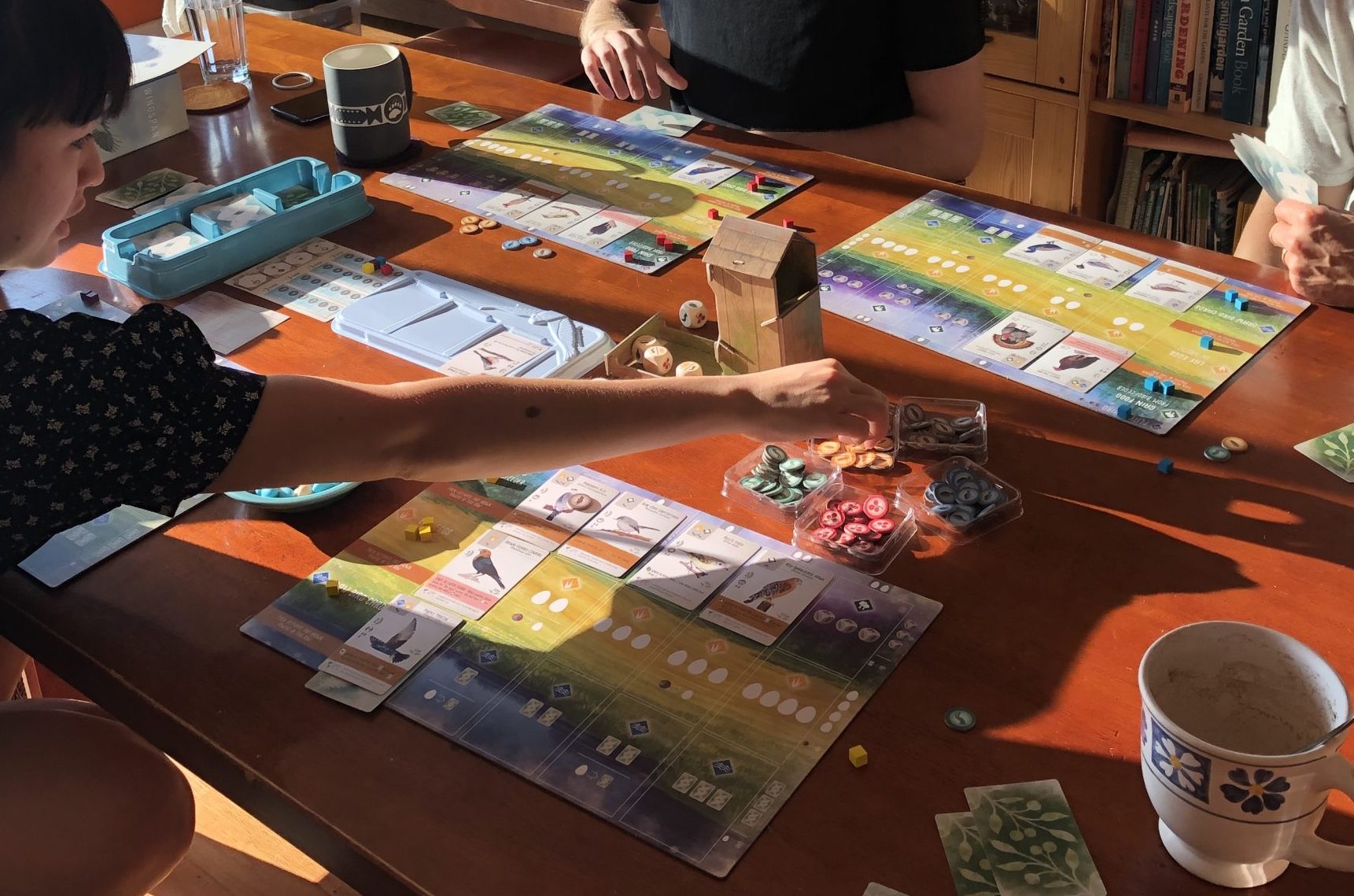
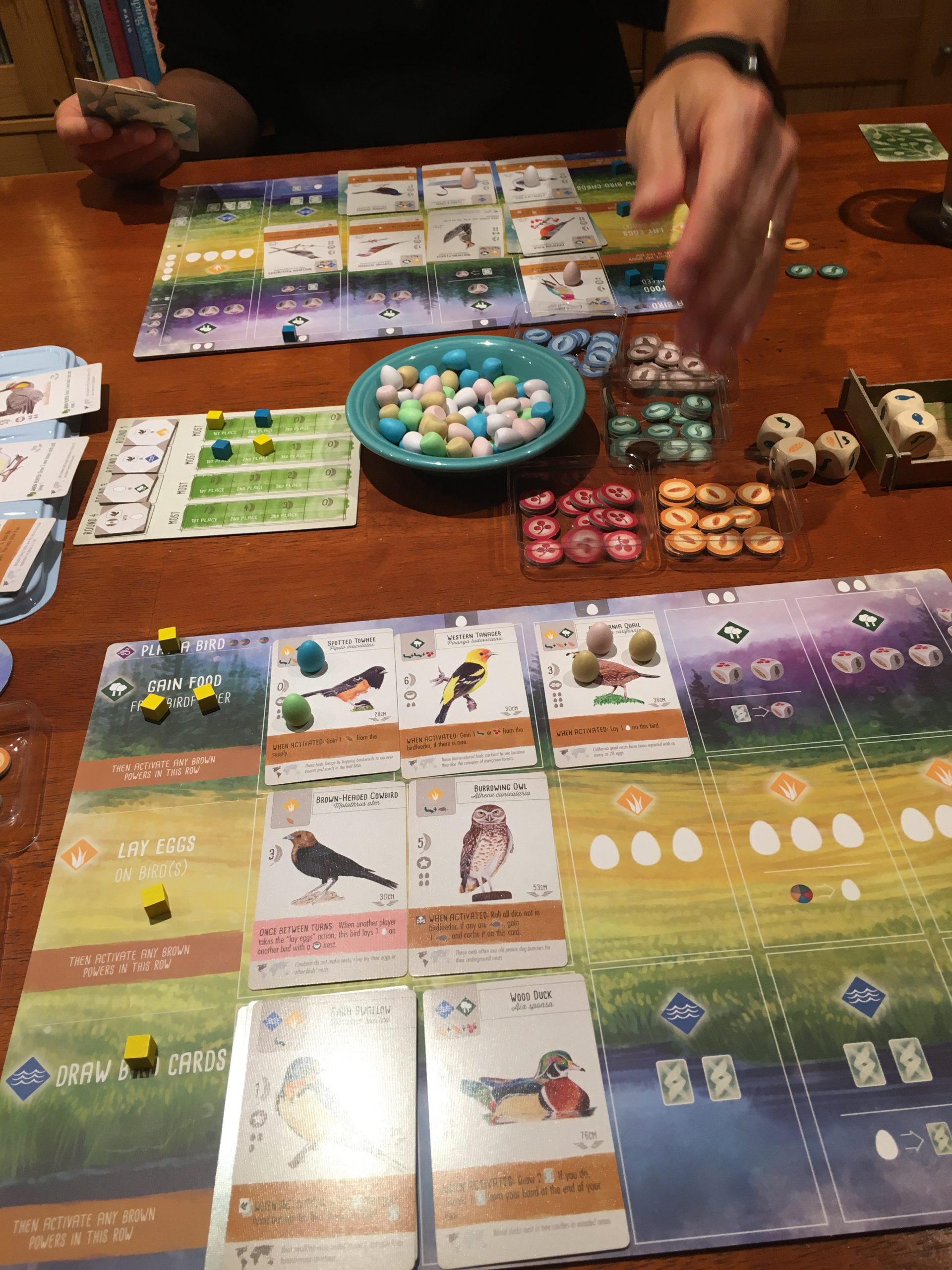
While you’ll be honing your strategy with each game, it’s important to not get too hung up on your strategy and remain flexible so you can make the most of the cards you get. You’ll be faced with many tactical decisions – which bird cards to keep or draw, in which habitats to build your birds, which actions to take and in what sequence, whether to activate certain bird powers, etc. With 170 bird cards with different values, features and powers, plus different bonus goals both for each individual and the group, no two games will be alike.
Interaction: Competition is friendly in this game: You’ll mostly try to do well for yourself. There is no potential to be really mean in this game – no killing birds, stealing eggs from others or the like. Overall, direct interaction is limited but you will be following the turns of your opponent(s) closely, as you’ll be competing for cards, food resources, and, of course, victory points. Also, some of the bird powers and actions of your fellow players may trigger benefits for you. While not an official part of the rules, we read the bird’s name and their special power out loud when they get played (you could also add the real life facts on the bottom), so everyone stays informed of what goes on in everyone else’s habitats.
Since this is a classic turn-taking game, you may at times have to wait a while for your next turn, but typically, with steps to plan and birds to explore, neither this nor the limited interaction have been big deals for us.
Ease of learning: There is a lot going on in this game, which can be a tad bit intimidating if you haven’t played other games that also employ elements like engine building or collecting and using resources before. However, don’t let that scare you away: The mechanics are actually quite simple and the instructions clear and straightforward. In addition, to ease beginners into the game, the box includes a sample starter set-up that guides players through the first few rounds until they get the idea. And should it still look confusing, there are some great instructional videos out there.
Playing with two players versus three, four or five is absolutely no compromise – it’s the exact same gameplay, no need for dummy players or the like. In fact, having just one opponent makes for more strategizing and faster game play. The only potential downside to a two-player game is that it can get a bit lopsided if one player has exceptional luck with their cards, though that is highly unusual, in our experience.
Single player version: Much thought has been put into the “Automa” version for solo players, making Wingspan a rare strategy board game that a single player can enjoy as well. The solo player plays a regular game of Wingspan and also takes turns for an imaginary “Automa” player. These turns are quick to execute, following their own set of rules. Special cards randomize the actions of the dummy player enough to keep things interesting, competitive, and surprisingly balanced, with a simple way to dial up the competitiveness (make the Automa’s bird cards more valuable). While it’s not difficult once you get playing, the instructions can be a bit confusing, and since they build on the multiplayer gameplay, I would imagine that it’s a lot to learn for a player who is brand new to the game. Instruction videos should help to illustrate the gameplay if needed.
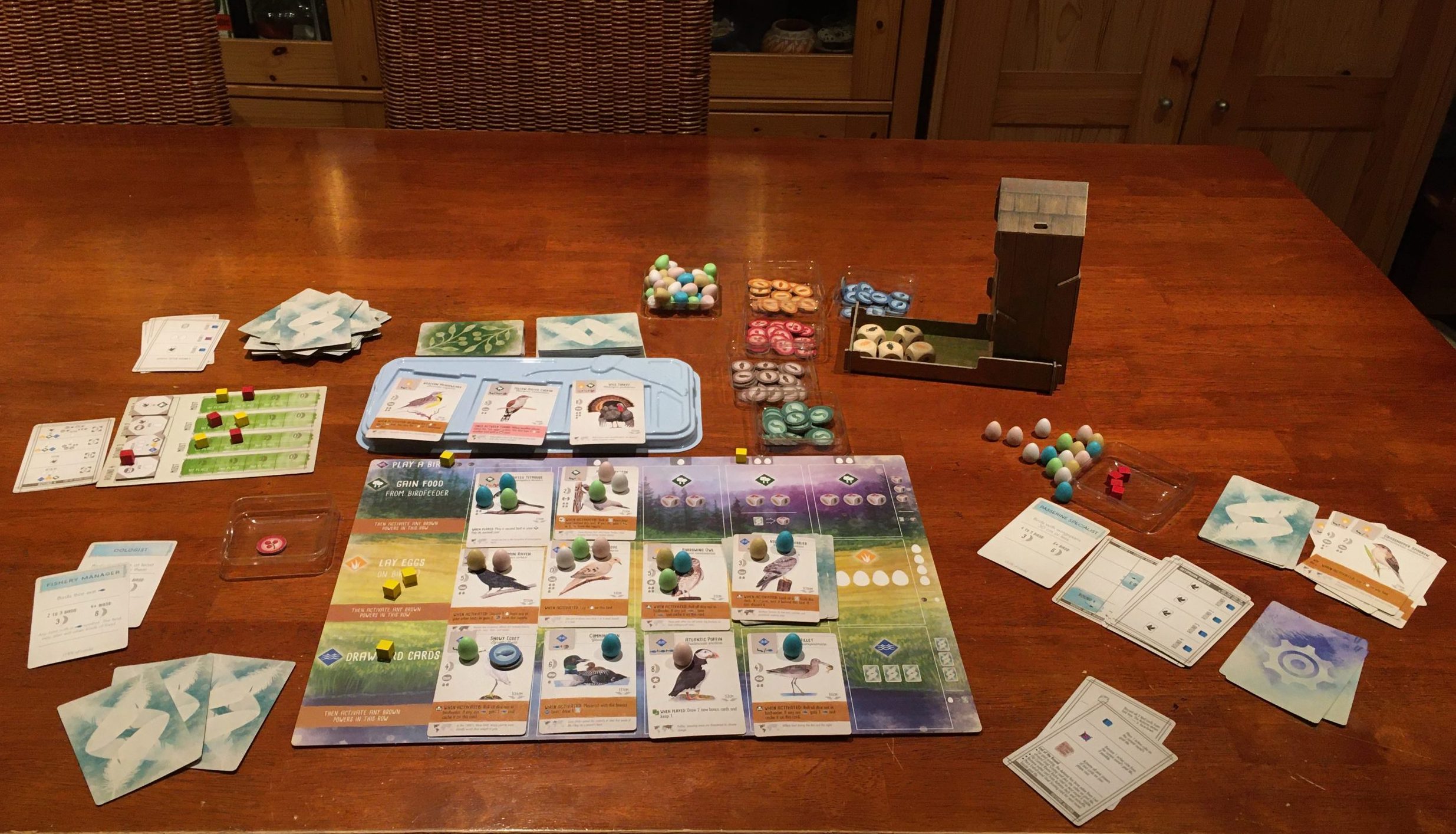
A single player Wingspan game using the Automa variant
Components: The interesting and challenging gameplay is complemented by high quality and attractive game components: Beautifully illustrated bird cards that rest in their richly painted habitat on your sturdy, individual play mat; different colored pastel eggs you almost want to eat; substantial wooden food dice that get rolled through a three dimensional birdfeeder; and even the rule booklets have a nice feel to them. With all the lovely details, even having to spend a few minutes to set up the game is enjoyable and just heightens the anticipation.
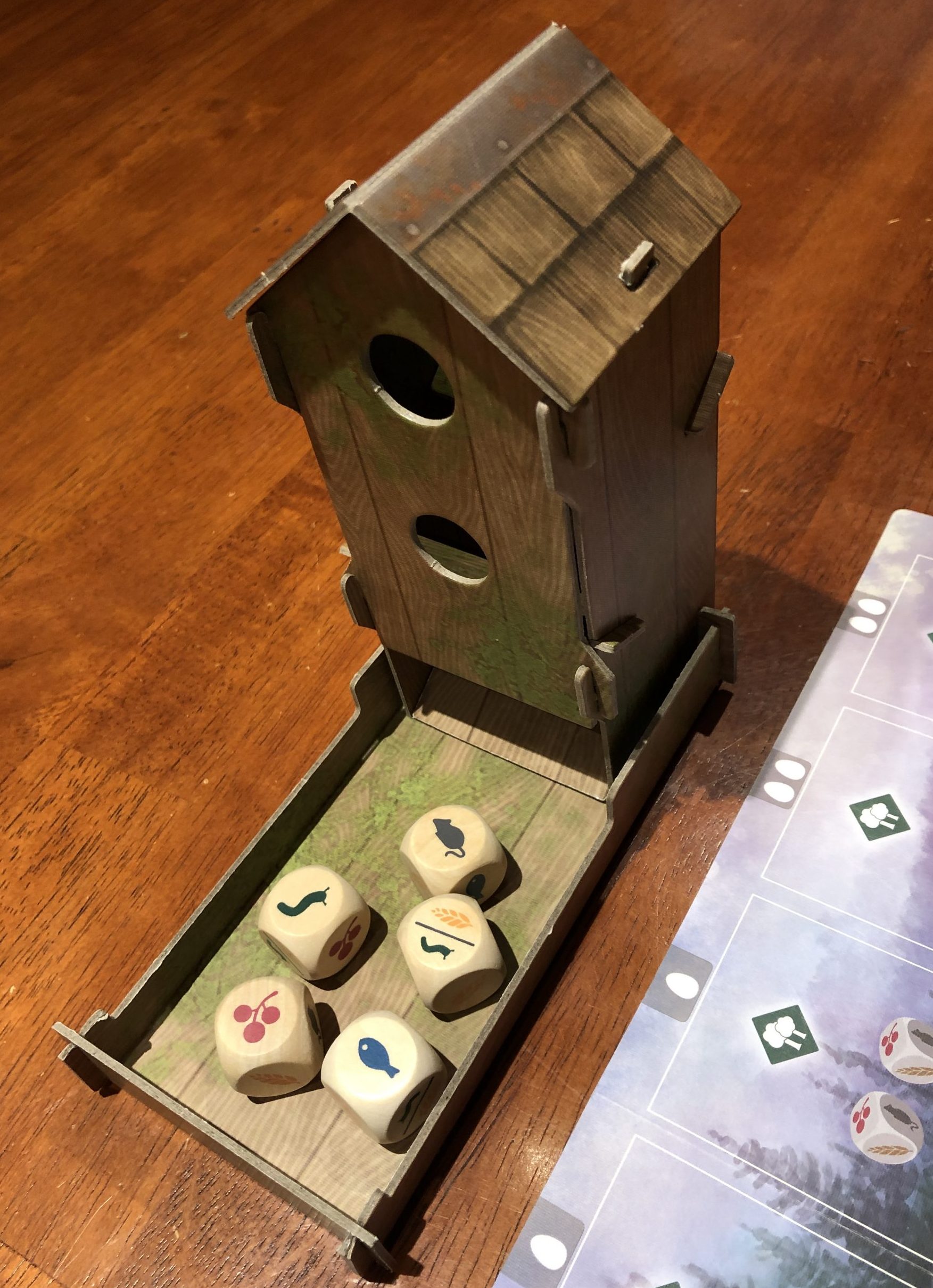
What I love about Wingspan:
- Lovely bird theme that is deeply integrated into the game play
- High replay value: With 170 bird cards and a variety of possible bonus goals, every game is different
- Good balance of luck and skill. Randomness of bird cards makes for interesting challenges, and an apparent lack of luck can be overcome with persistence and clever play
- Many different ways to score points; no run-away winners
- Friendly competition – no one gets eliminated or robbed, no birds killed (not by players, anyway), and there is no hand limit
- Excitement and tension builds with the rounds
- Versatile number of players – excellent game for couples/pairs, groups up to five, and even for one solo player
- Nicely detailed, high quality game components, which fill the sturdy box completely – no fluff here
- You learn about birds!
Good to know:
- Wingspan is language dependent – you need to be able to read what’s written on each card
- The game requires a considerable amount of tabletop space
The not-quite-perfect:
- Limited direct interaction and classic turn-taking mechanics, meaning you may have to wait a while for your turn
- Not a cheap game, but you are getting a lot of value for your money
- The many smaller game components are stored in plastic baggies rather than a box insert, but this might make the best use of the box space.
Fun aftermarket components
While Wingspan comes with lots of great pieces and details, some of these can be improved on. Consequently, there is a whole aftermarket for Wingspan components on Etsy, from box organizers to a sturdier birdhouse for rolling the food dice. My favorite upgrade, personally: Replacing the little wooden action cubes, which keep track of each player’s actions, with little birds. Take a look at the photos below – isn’t is so much cuter to use birds as action and score markers?
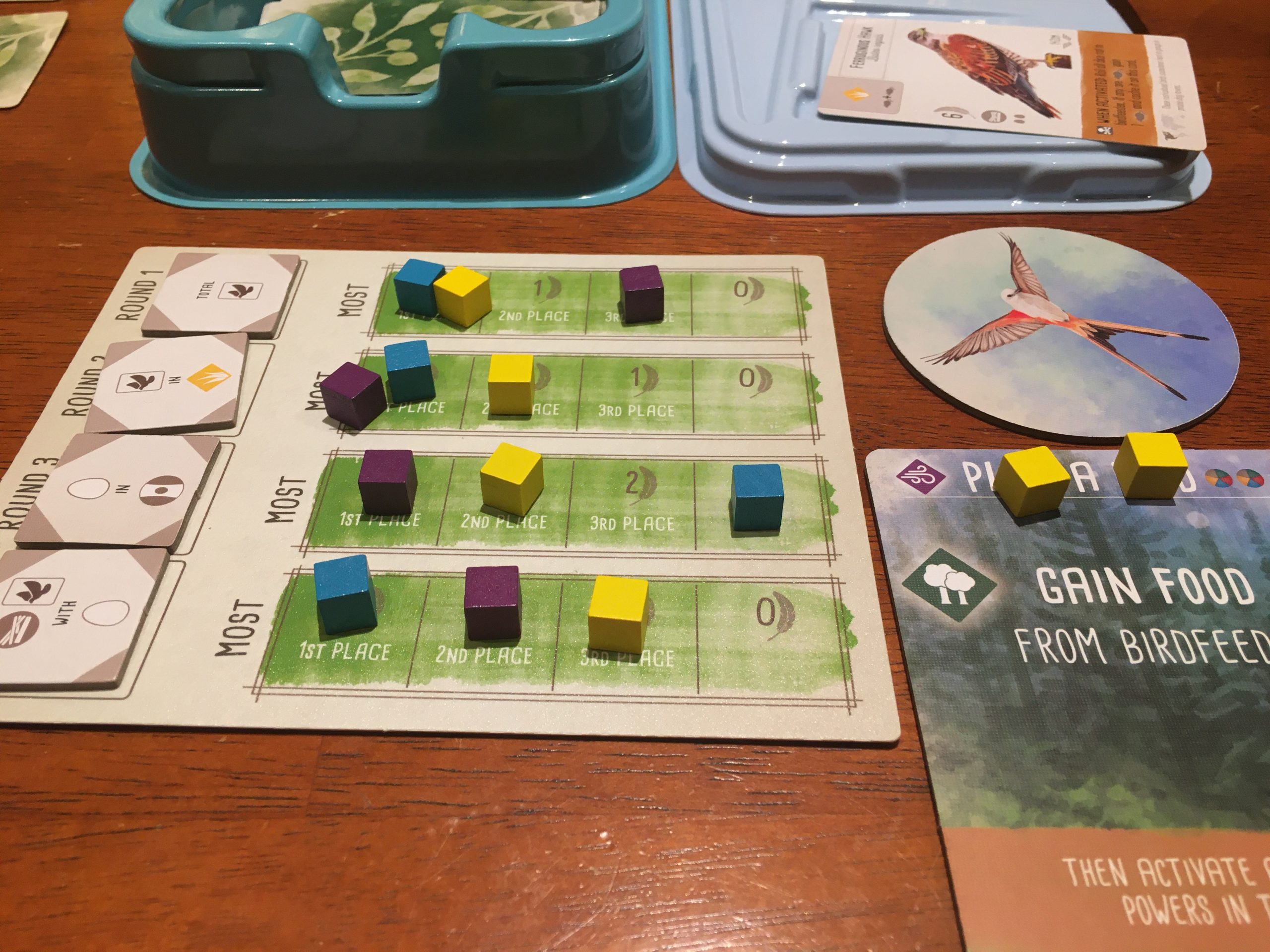
Wingspan game details with wooden action cubes and round starting player marker that come with the game
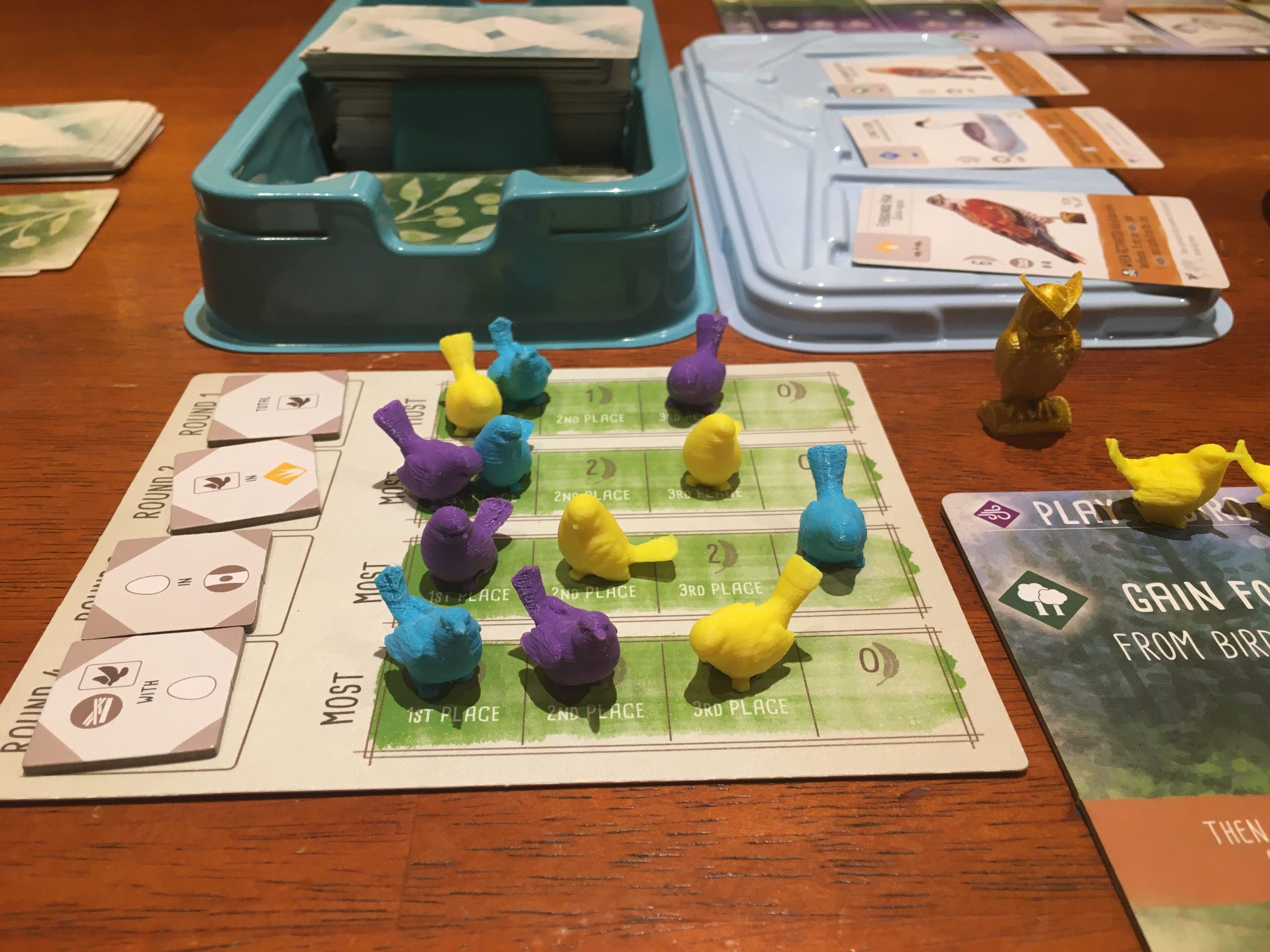
Wingspan game details with Etsy aftermarket bird meeples replacing the wooden action cubes and owl marking the starting player
7 WONDERS
The Original Multiplayer Game
Engaging, multi-dimensional strategy game for small to large groups
-
30-40 minutes, 3 to 7 players
-
Designed by Antoine Bauza and Bruno Cathala, published by Repos Production
- Multiple awards, including “Kennerspiel des Jahres 2011” (connoisseur prize)
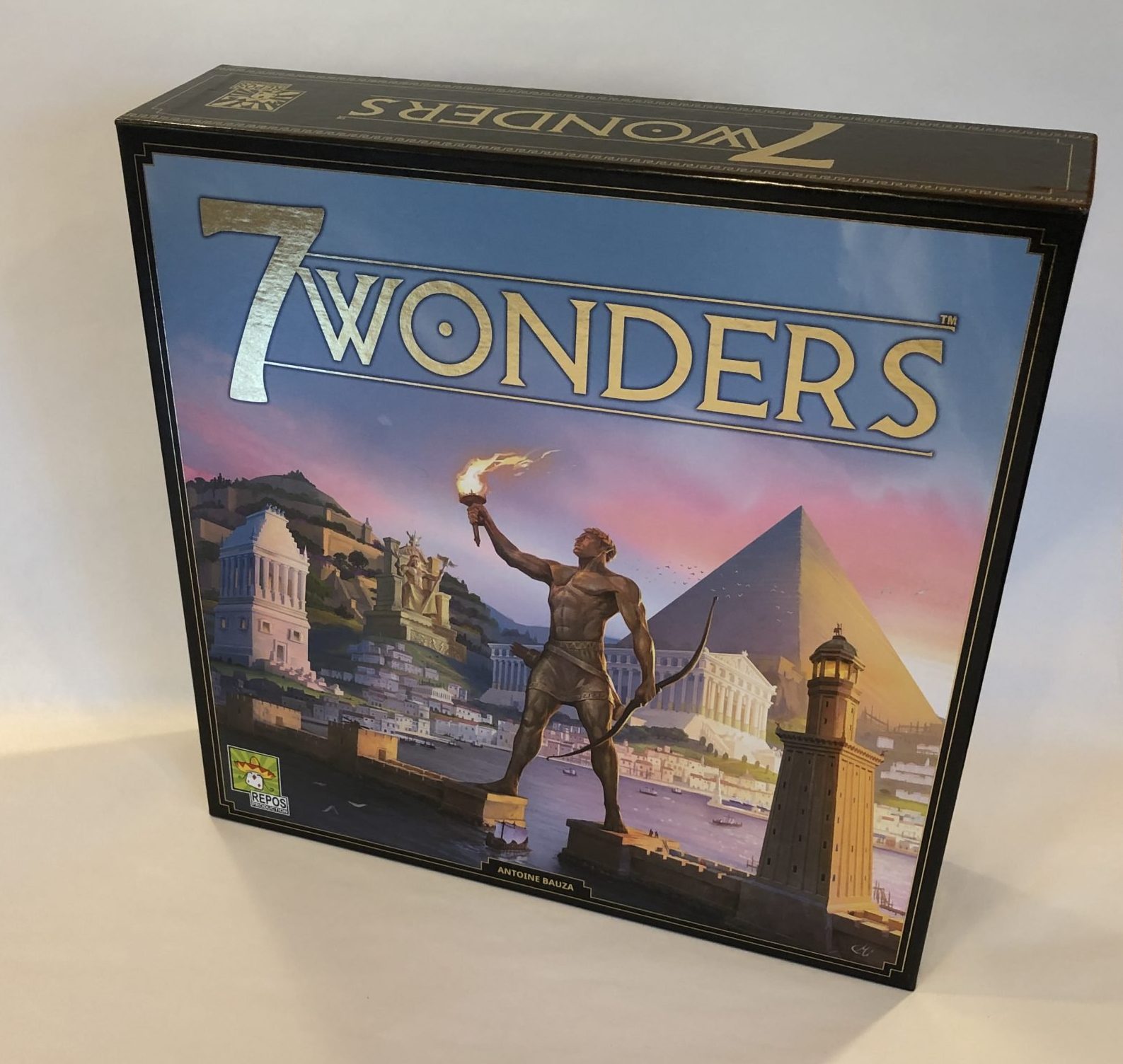
Seven Wonders is our go-to game with larger groups: You can play it with up to seven players; simultaneous gameplay, with all players taking their turn at the same time, keeps everyone engaged at all times; and it’s easy to teach to new players, some of whom have even won their very first game. Add to that many different ways to win points, a decent balance between luck and strategy, and fast game play, and you have a game that everyone seems to enjoy.
The game is set in ancient civilizations and the original seven wonders of the world. Boards and cards are richly illustrated and of nice quality. Players use cards to build structures and wonders, make scientific discoveries and wage military battles.
In 7 Wonders, you make lots of decisions and feel a certain amount of control, but there is also luck, randomness and, of course, the actions of the other players that influence the outcome of your game. Since room for strategy is fairly narrow, and focusing on just one category of victory points will almost certainly not lead to a win, the game feels a bit more tactical rather than strategic. Part of the beauty of this game is that you need to flexibly adapt to the course of each game and the changing situation, the cards you can pick from, the individual wonder board you got dealt etc., and that you can always try out a different approach in a new game. And that new players have a fair shot at doing well!
7 Wonders life lessons:
- Adapt to your situation; be flexible and open to new opportunities
- Diversify your investments
- Don’t be intimidated by something that looks complicated on the surface!
The gameplay really comes down to just a few actions: At the same time, everyone chooses a city card from their current hand of cards. Then, again all at the same time, you use this card in one of three ways: Build it into your city, discard for money, or tuck it under your wonder board to build one of its stages. Unless you trade your card for money, you have to pay a cost for most cards, either from your own resources (which do not deplete once built – you either have a resource or you don’t), by paying one of your immediate neighbors who has the required resource, a combination of both, or by already having built a card/structure that allows you to acquire a specific, related card at no cost. Paying is essentially on honor system, since everyone just does it on their own and all at the same time. One time a new player in our house did astonishingly well – until we realized that she had missed the part about having to pay a cost for building structures…
There are seven different types of cards or structures to play – science, civilian buildings, resources, military etc., which give you different resources, points or powers. In some card categories, having certain combinations of cards produces greater value or power. While it’s good to diversify your structures somewhat, you will need to decide which cards to take and what areas to focus on, which is where the strategy comes in. The cards themselves are pretty self-explanatory, so you won’t have to keep looking up cards or symbols, and the important symbols and icons can be made out from the distance – important since you’ll want to keep track of what others are playing.
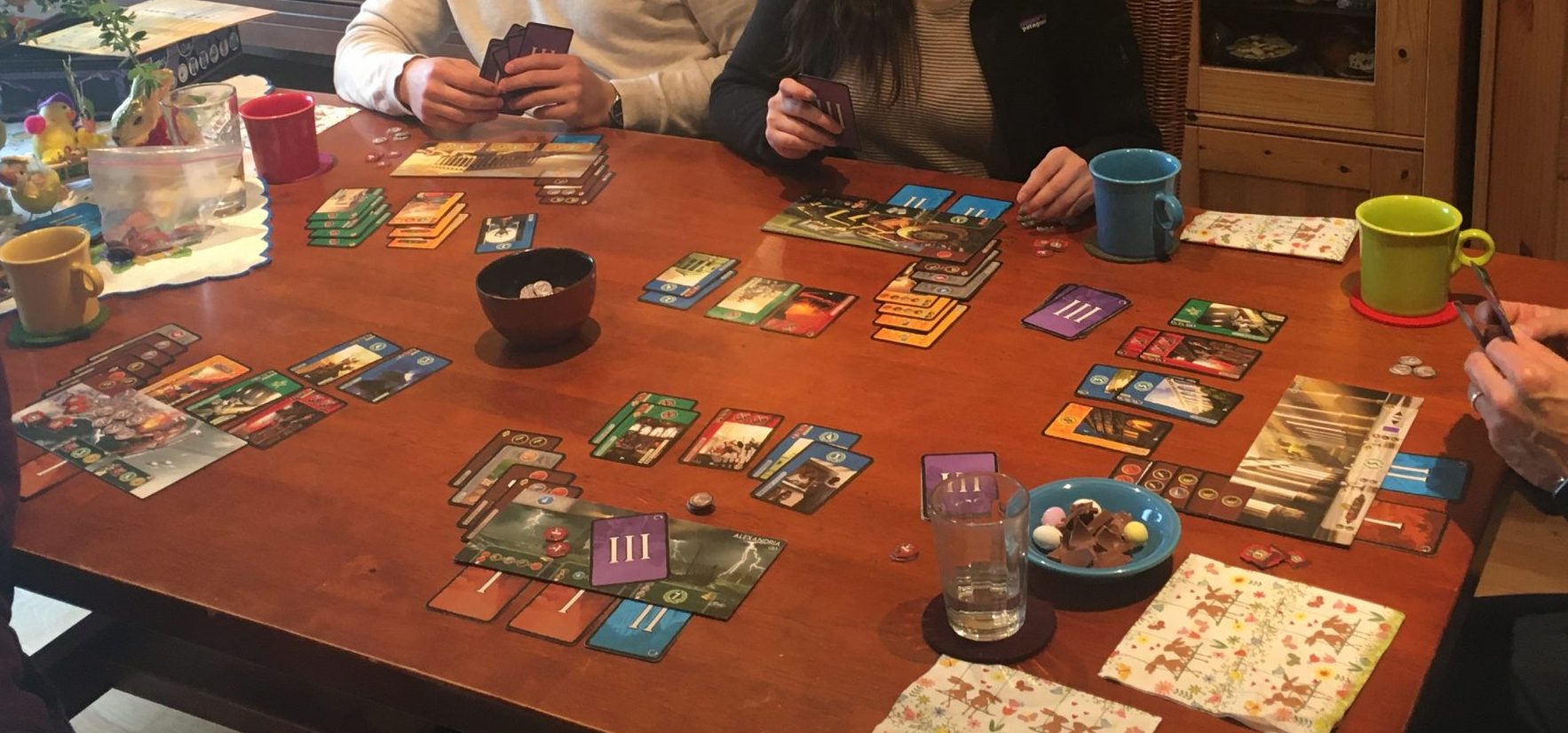
A five player game of 7 Wonders, first edition (Easter chocolates and deco not part of game 😉
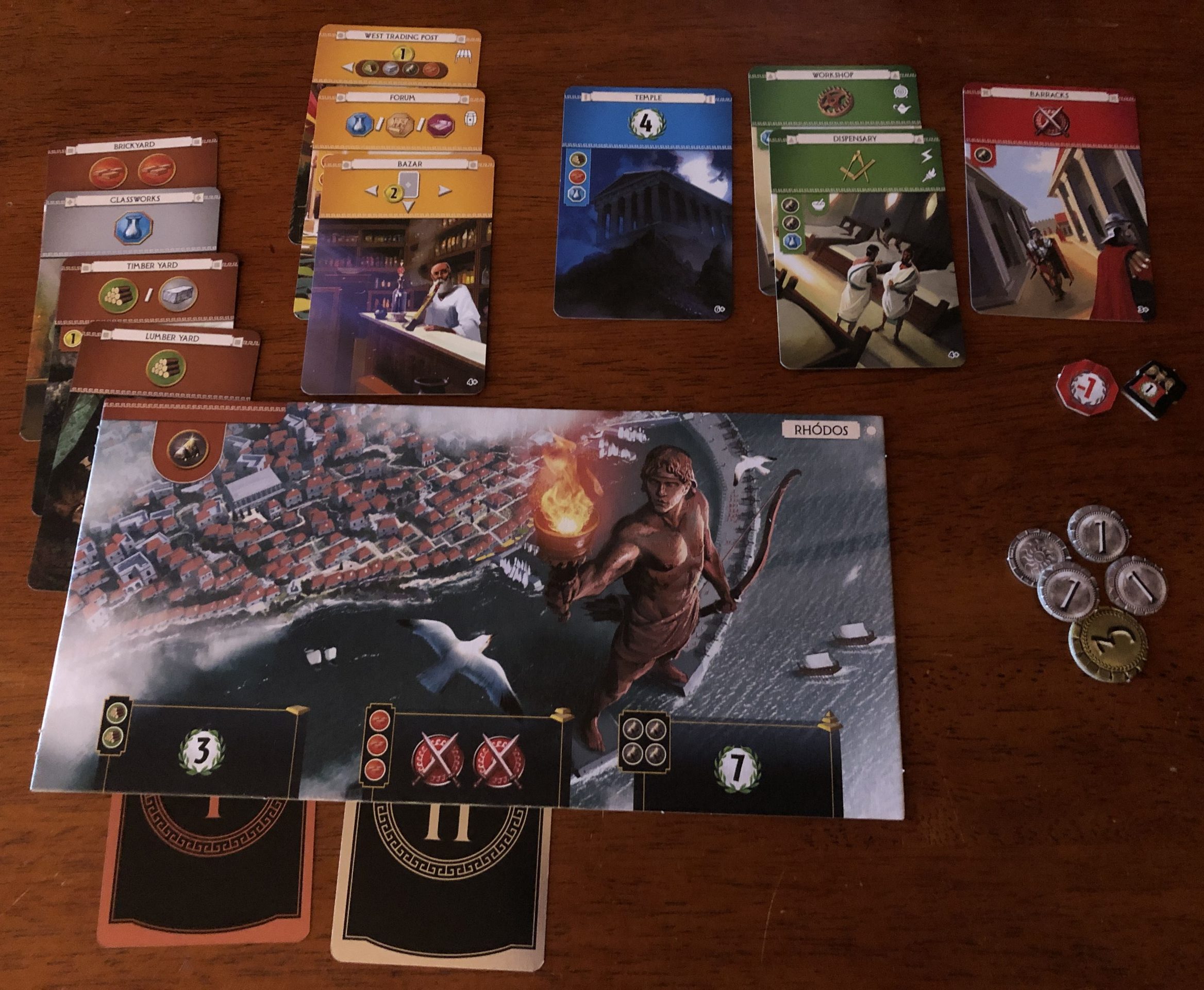
One player’s layout well into the game
The interesting method of card distribution (also known as a booster draft) adds a measure of fairness, or mitigation of luck, as well as room for tactical decisions: Every player starts each age with a random hand of cards. After picking a card, you pass your hand of cards on to your neighbor on one side and receive a new hand of cards from your neighbor on the other side, to pick from on your next turn. This mechanism keeps repeating until the last turn of each age, with a choice of just two cards
After three phases or “ages” that progress from heavier on resource-building to higher on point scoring, everyone’s points in seven different categories are tallied in the provided score pad. Typically, the winner has a fair number of points in several categories, so it pays to invest in different areas and not be too stuck on any one path to victory.
The only direct competition happens in military points, where you can earn – or lose – points based on how your military power (as measured on shields on your military cards/structures) compares to that of your immediate neighbors. That competition can get quite fierce, though, and there are usually a few warmongers at the table that you can either fight – with no guarantee of winning – or capitulate to. You’re in luck if your neighbors are pacifists!
Ease of learning: A first look at the rules and cards can be intimidating, since there is quite a lot going on – but not to worry, you’ll get the hang of it fast (and if you find the rules confusing or don’t have a good explainer, there are lots of video tutorials out there). Also, the new 2020 edition has made many efforts to make the rules and game play more accessible and easy to understand.
With many interesting games limited to four or at most five players, having such a fun and engaging light strategy game for up to seven players is a real godsend. That said, the game arguably plays a bit better with fewer players because you are directly competing or interacting with all or most participants. Then again, you’ll play with a wider variety of cards with more players. By all means, don’t think of this as a party game, but as a lighter strategy game that works well with groups of many sizes.
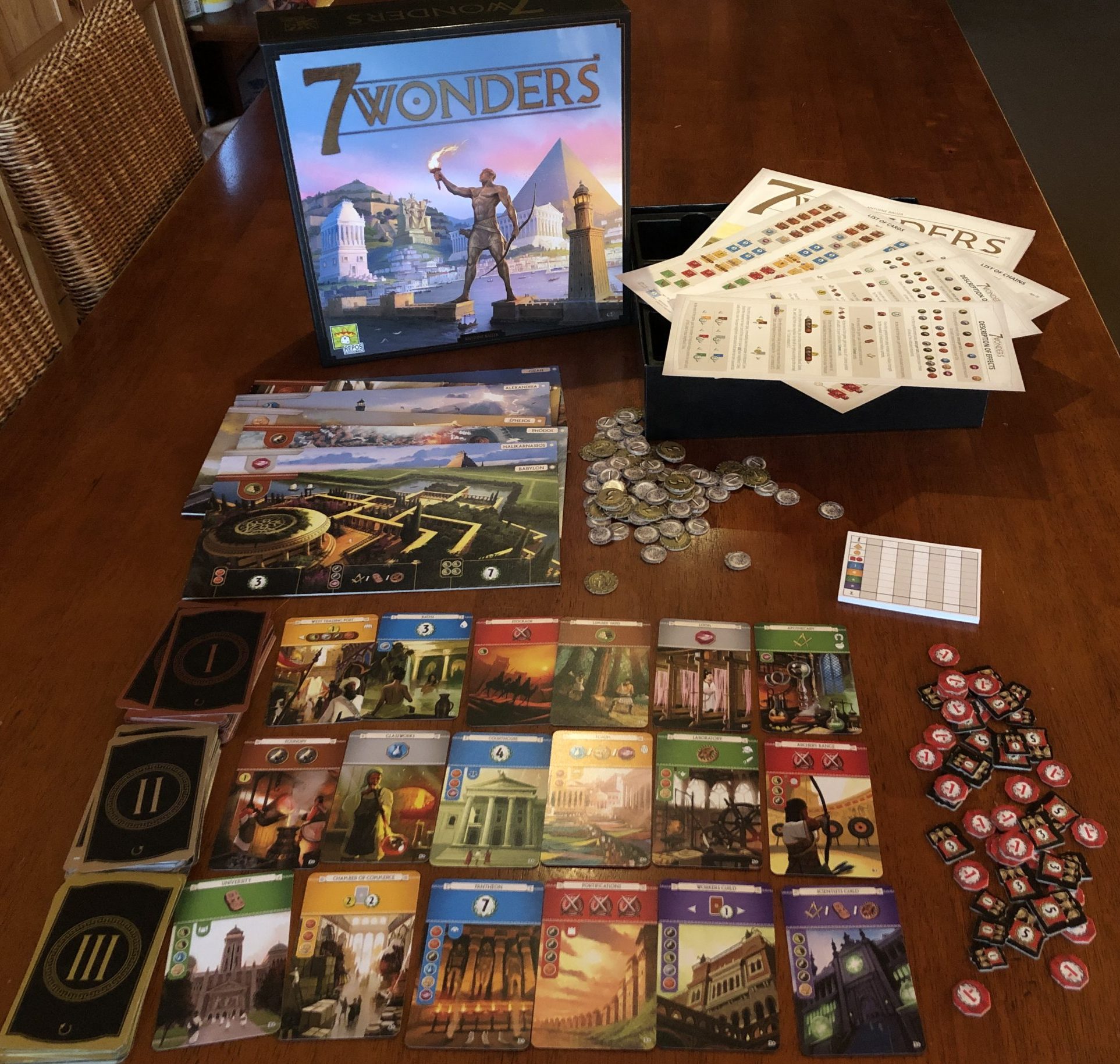
7 Wonders components
With its variability, you should be able to play 7 Wonders many times without getting bored. If you do look to change things up a bit, there are several expansions that can add to your civilizations, wonders, cards and gameplay.
If 7 Wonders sounds interesting but it’s only two of you, check out 7 Wonders Duel, which is 7 Wonders completely redesigned as a solid and interesting two-player game.
What I love about this game:
- Simultaneous gameplay: With all players taking their turns at the same time, everyone is always engaged, there is no downtime, and the game plays fast even with six or seven players
- Plays with up to seven players, which is rare for a strategy game
- Quick gameplay, so you can always play just one or add another one
- High replay value: Randomness of cards and wonders and the many ways to make points make each game feel different.
- Easy to teach new players
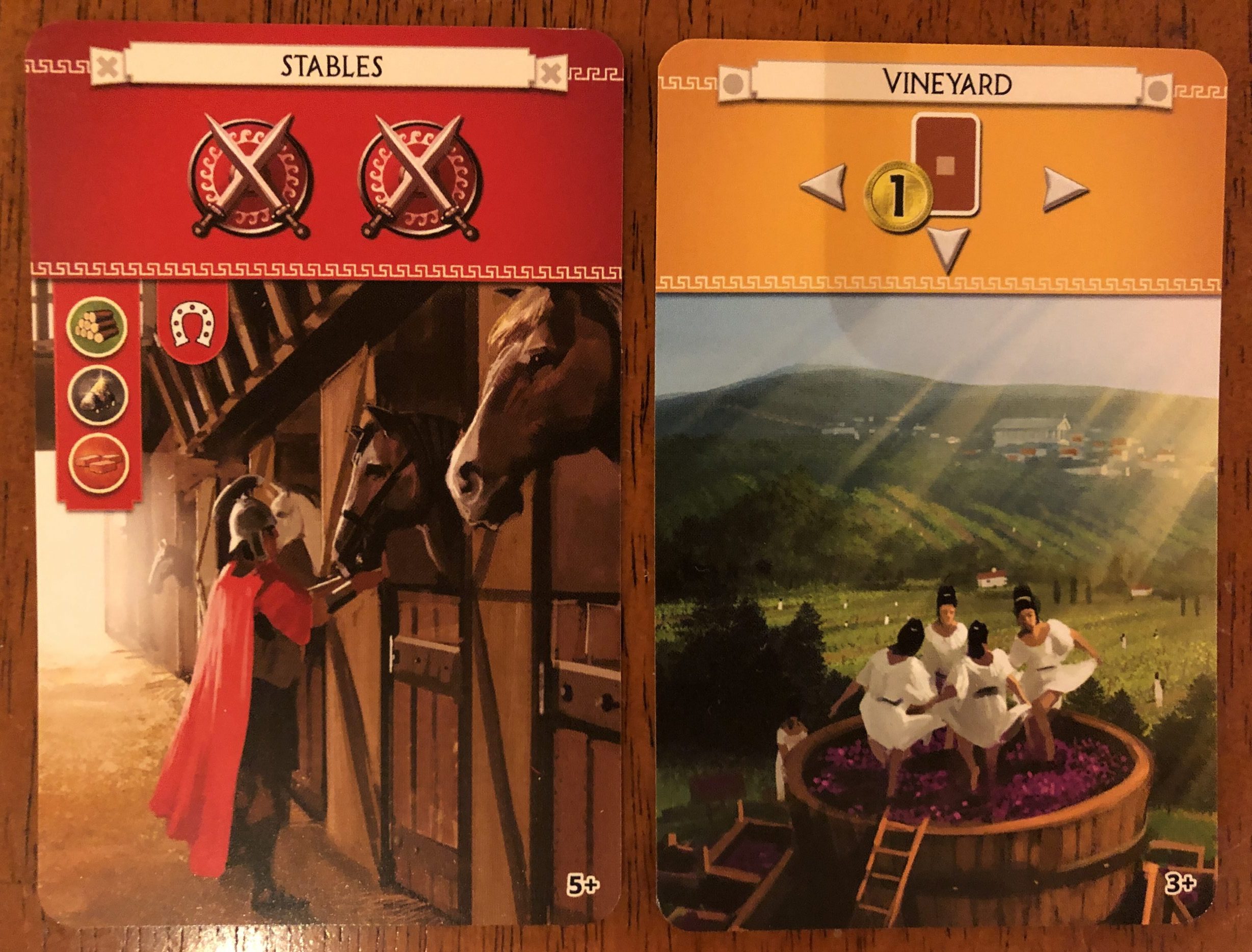
Good to know:
- Requires some set-up and a good amount of tabletop space
- The gameplay does not require a specific language or reading
The not-quite-perfect:
Note that the first two potential drawbacks have benefits in that they keep the game moving even with a large number of players
- Limited interaction: While all play at the same time and no one will get bored, you are very much focused on building your own city. You’ll keep an eye on what others are doing and pay your neighbors for resources, but even that is a one-sided affair rather than a negotiation (“Here is two coins for your stone”).
- Your interactions, direct competition on military and your sphere of influence are limited to your immediately adjacent neighbors
- Can look intimidating to new players at first
WIZARD
Genius little card game that is super fun and engaging yet also challenging
-
3-6 players; 40-90 minutes (playtime varies inversely with number of players, from about 40 minutes for 6 players to 90 minutes for three players)
- Designed by Ken Fisher, published by US Games
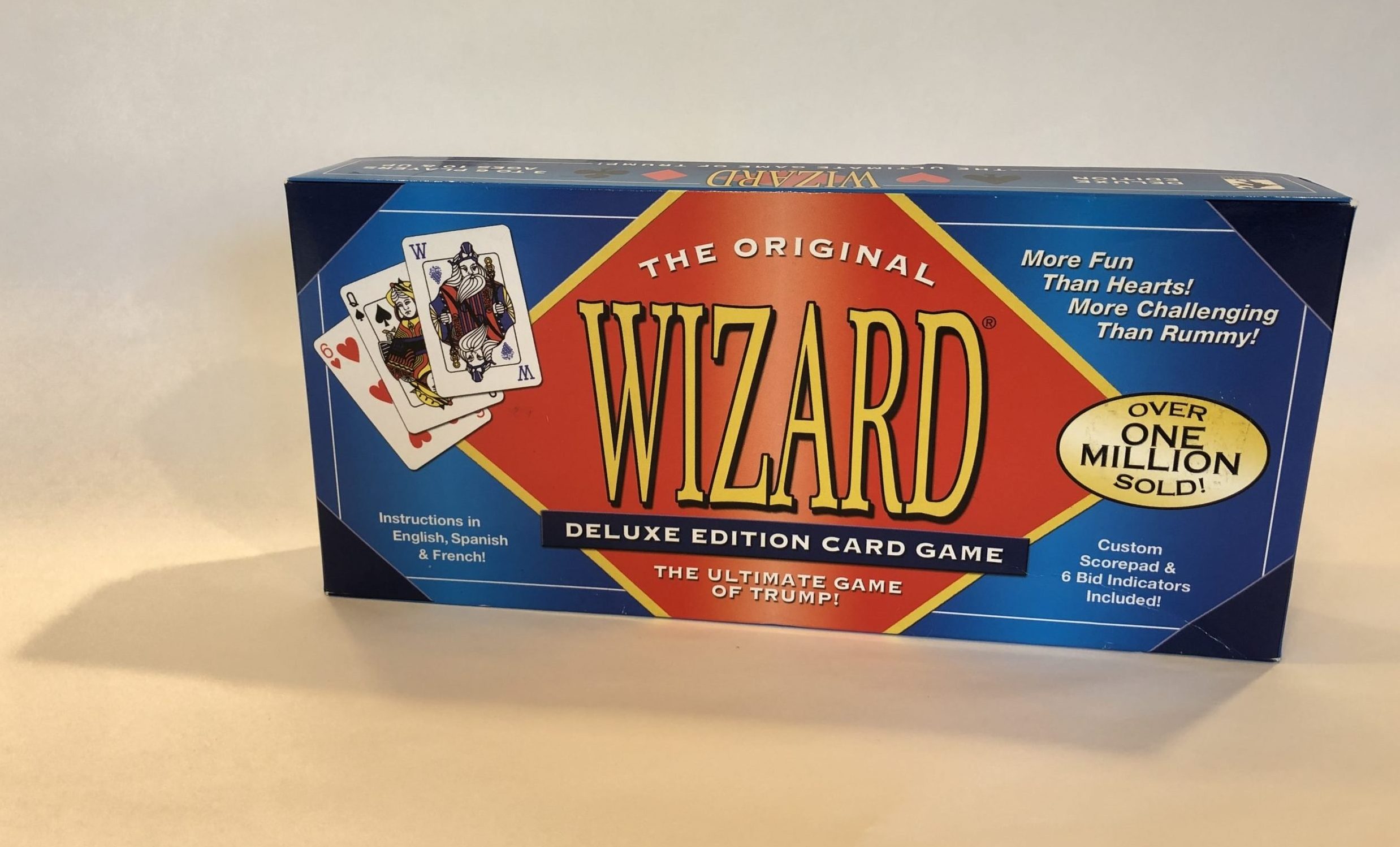
Sometimes, good things come in small packages. This is a card game I’d trade many of my large, beautiful and much more expensive board games for – it’s just that much fun. Wizard puts an interesting twist on traditional trick taking card games, is highly engaging and interactive, accommodates group sizes from three to six, and it’s not hard to learn.
But be warned: This game is highly addictive! I first got it because a friend posted on Facebook that her family had been playing it obsessively all summer. Sure enough, we got hooked as well. Years later, we still love to come back to this very competitive, fun and social game.
Wizard life lessons:
- You need to find a balance between being conservative and aggressive – too much of either and you’ll lose!
- Taking a whole new perspective on a known thing can be really worthwhile
- Recognize a good hand or opportunity when you see one and work to realize its potential
- You get to apply statistics and probability
- Don’t judge a book – or game, or anything else – by it’s cover. You don’t know what treasure may be hidden behind a plain exterior!
Gameplay overview: This card game puts traditional trick taking (winning the cards all players play in one turn) on its head: The goal is not to get as many tricks as possible, but to accurately predict how many tricks you will take in one round. Coming in over is just as bad as falling short of your bid. That said, the potential reward is higher when you bid high and succeed. So you need to find that balance between being defensive and aggressive, play accordingly and hope for the best.
The Wizard card deck includes a traditional deck of cards, with cards from two to ace, plus two kinds of special cards: Four Wizards and four Jesters that can be played any time, even if you can follow suit. Jester always looses (which comes in very handy when you need to avoid getting tricks), while the first Wizard played always wins the trick. This makes for interesting strategizing and for surprises that are as painful for one player as they are fun for the others (“You’ve been wizzed!”).
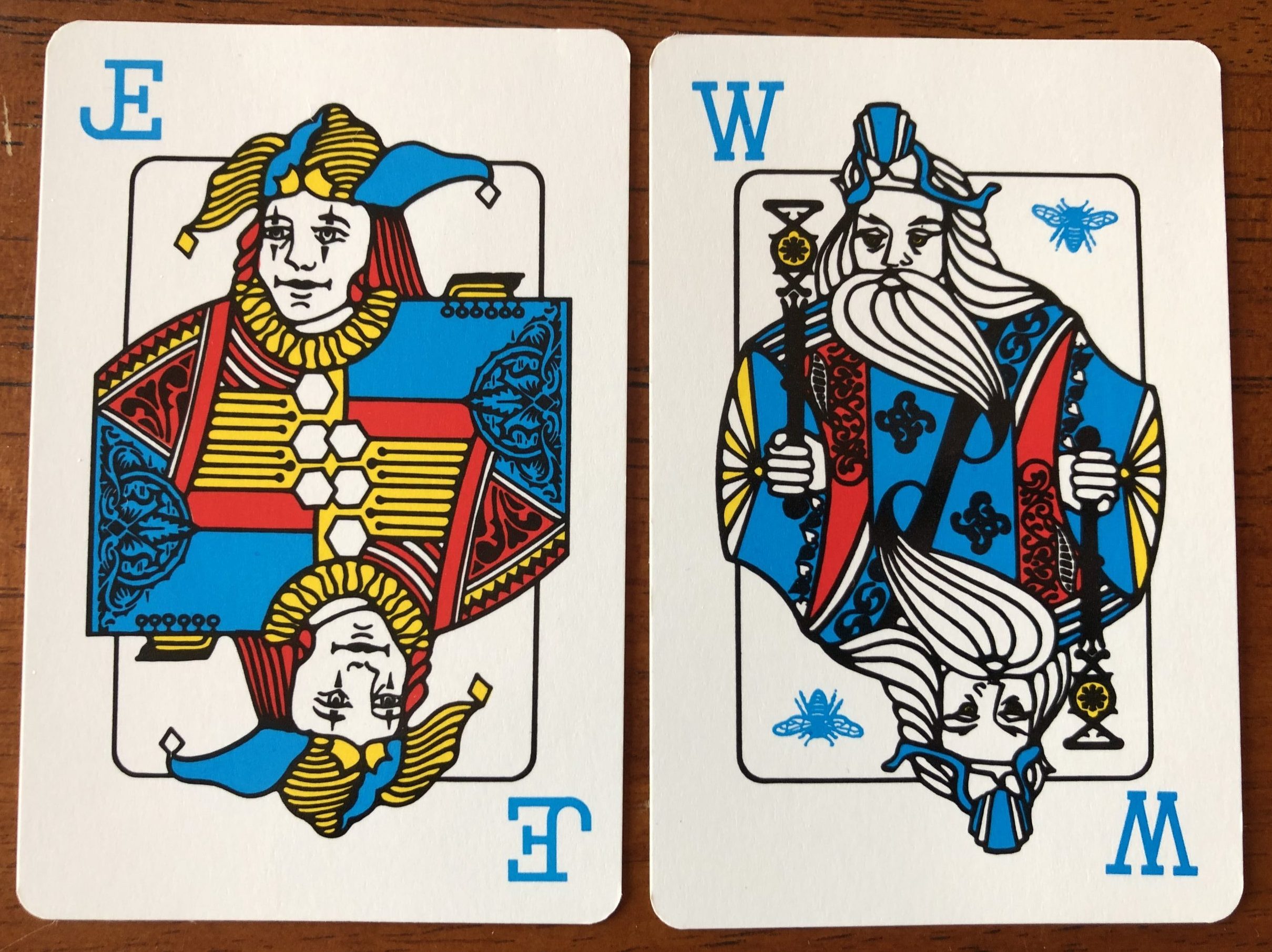
The bids are either announced and recorded on the score pad or, if you have the Deluxe version, done by each player on their individual bidding disk and revealed consecutively, simultaneously or kept hidden until the end of a round. Any of these variations change the dynamics and strategizing, so you can mix it up or find your preferred variant.
Skill and strategy are very helpful in this game, but the random draw of the cards, the unpredictable use of Jesters and Wizards, and, of course, never knowing what other players will play, add just the right amount of luck to keep tension and excitement high.
Ease of learning: If you have played other trick taking and classic card games before, you’ll only need to add the rules around the two special cards – jesters and wizards – and wrap your head around the fact that you are going after accurately predicting the number of tricks, rather than taking as many tricks as possible. And then, of course, develop the necessary strategies. If you haven’t played classic card games before, you’ll need to understand the concepts of suits and trump first. It’s not too hard, and trust me, it will be well worth it!
The length of a game of Wizard varies a lot with the number of players. It’s fastest with the maximum number of players, due to the card dealing mechanics: The first round starts with just one card dealt, to which one card is added in each round until there are no cards left to deal. Consequently, three players play 20 rounds, with 20 cards for each player in the last round, four players play 15 rounds, five 12 rounds and six players play ten rounds, with just ten cards per player in the last round. This makes for quick games with five or six players and significantly longer games with fewer players. We sometimes break a game with just three or four players into two sessions – the nifty score pad makes it easy to pick up where you left off.
As for scoring, we don’t score in the suggested tens but leave off the zero at the end – why score 20, 30 or minus ten if you can just score 1, 2, or -1?. We’ve personalized Wizard in a couple of other ways as well: We use the hidden bidding variant as our standard version, since it seems fair and also more fun if everyone does their bidding simultaneously and independent of what others have bid already, plus it’s faster; and we definitely keep the bidding disks in front of each player for everyone to see, since it adds to both fun and strategy to see where someone’s actual tricks stand in comparison to their bid.
In our experience, the individual bidding disks, which are only contained in the Deluxe version, are an integral part of the gameplay, since they allow all players to make their bids hidden and simultaneously, to then reveal them either all at the same time or delayed. Plus, being able to see everyone’s bids in front of them informs strategy and adds to the fun, or Schadenfreude, when someone overshoots their bid. If you do not have the disks, you could use alternatives like coins, beans or individual pen and paper for each player.
There isn’t much of a theme or anything cute here: The game consists of the very standard-looking card deck, a well designed score pad, and, if you get the Deluxe version, six bidding disks. It’s just a fun and interesting game with simple, good game mechanics – but you wouldn’t necessarily know that from looking at the box or components.
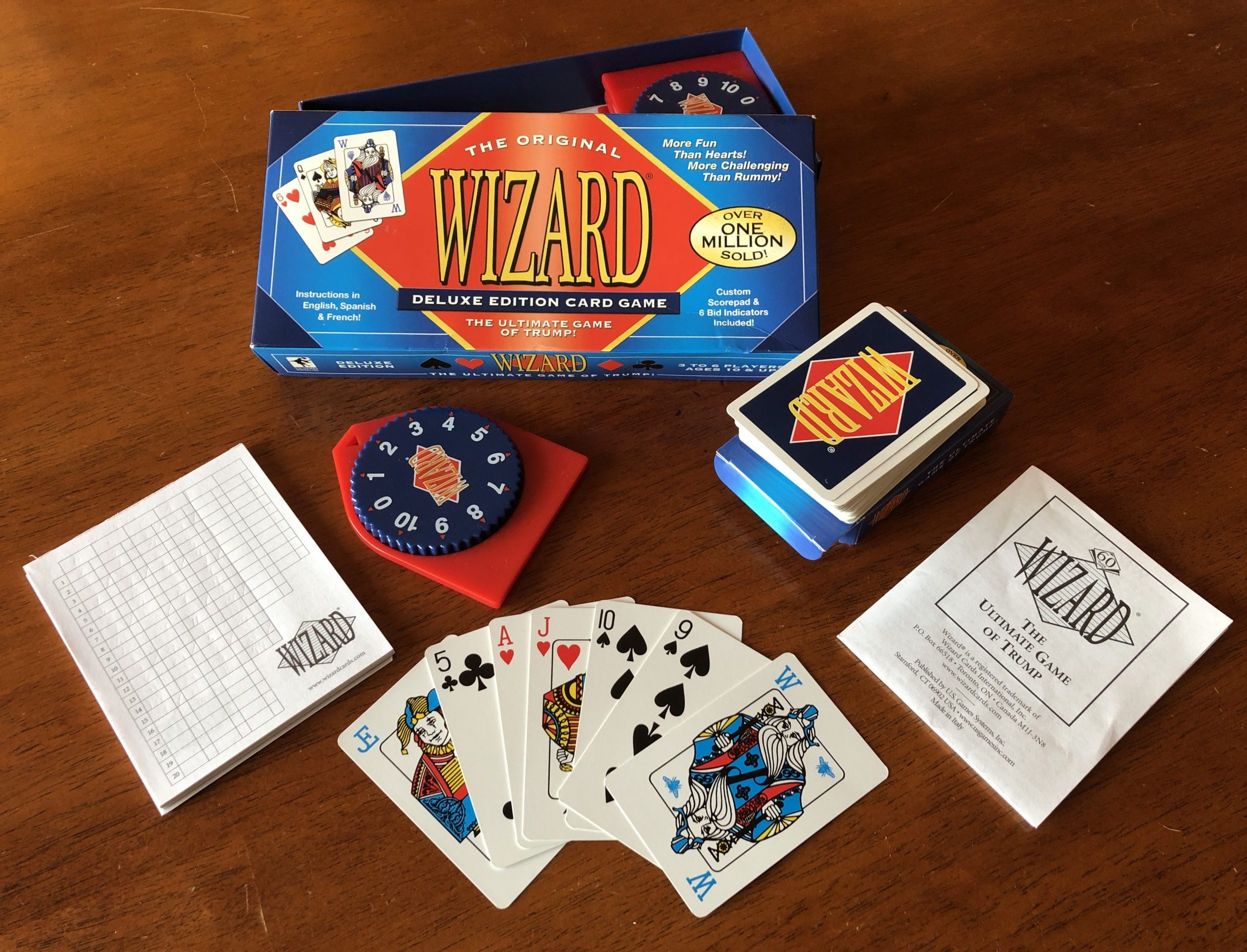
What I love about Wizard:
- Highly engaging with no downtime
- Very social and interactive
- Simple and clean rules
- Twist on a known game play that changes everything
- Great balance between luck and skill
- Exciting and fun
- Plays with 3-6 players
- Very affordable
Good to know:
- Can be played just about anywhere – small table, picnic blanket…
- No language or reading required
The not-quite-perfect:
- Should be sold standard with bidding disks
Shopping:
A little card game shouldn’t be hard to shop for, but you actually have three choices:
1. Wizard Card Game, Deluxe edition. Includes playing cards, score pad plus six bidding disks. – If you can afford it and it’s available, get the Deluxe version; the bidding disks are an integral part of the game, not a luxury!
2. Wizard the Card Game. This ultra affordable version contains just the playing cards and a score pad. – If you go with this version, get a little stash of items (pennies, pebbles, beans…) or make little cards with the numbers 0-10 for each player, so everyone can bid simultaneously and put their bid in front of them for all to see.
3. Fantasy Wizard. Includes fantasy cards plus score pad. – This is a visually more interesting version of the card game, with elf characters numbered from 1-12 plus a flag (ace) for each suit. This might be especially appealing to kids who are used to richly illustrated games. Note that the US version is (barely) adapted from its German original, so that Wizards and Jesters are denoted not with W and J but Z (for Zauberer) und N (for Narr). This game comes in a small minimalist package without individual bidding disks, so gather some coins or beans to indicate everyone’s bids.
More game reviews coming soon!
Never miss what might become a favorite new game! Sign up below to be notified of new game reviews from For the Love of Board Games by email, and/or follow facebook.com/ForTheLoveOfBoardGames
